Abstract
Crystalline silicon (Si) is the key material of the semiconductor industry, with significant applications for electronic and microelectronic devices. The properties of Si are affected by impurities and defects introduced into the material either during growth and/or material processing. Oxygen (O) and carbon (C) are the main impurities incorporated into the crystal lattice during growth via the Czochralski method. Both impurities are electrically neutral, however, implantations/irradiations of Si lead to the formation of a variety of oxygen-related and carbon-related defects which introduce deep levels in the forbidden gap, inducing generally detrimental effects. Therefore, to control Si behavior for certain applications, it is important to have an understanding of the properties and fundamental processes related with the presence of these defects. To improve Si, isovalent doping during growth must be employed. Isovalent doping is an important defect-engineering strategy, particularly for radiation defects in Si. In the present review, we mainly focus on the impact of isovalent doping on the properties and behavior of oxygen-related and carbon-related defects in electron-irradiated Si. Recent experimental results from infrared spectroscopy (IR) measurements coupled with theoretical studies involving density functional theory (DFT) calculations, are discussed. Conclusions are reached regarding the role of isovalent doping (carbon, (C), germanium (Ge), tin (Sn), and lead (Pb)) on the suppression of detrimental effects introduced into Si from technologically harmful radiation clusters induced in the course of material processing.
1. Introduction
After many decades of research, Si continues to be an important material in the semiconductor industry. It is the main element for the fabrication of integrated circuits, solar cells, detectors, sensors, semiconductor lasers, fast-responding transistors, etc. Additionally, it is used for applications in important scientific fields which impact our daily life, such as quantum computing, nuclear medicine, and the aerospace industry [,,,,,,,].
The properties of materials in general are largely affected by impurities and defects introduced into the lattice during growth and processing. In the case of Si, O and C are the two main impurities incorporated into the lattice during growth. Both are electrically inactive, but during irradiation and subsequent anneals at various temperatures they lead to the formation of a number of oxygen-related defects such as VnOm complexes [,,,,,,], and carbon-related defects such Ci, CiOi, CiCs, CiSiI, CiOiSiI, and CiCsSiI complexes [,,,,,,,,,], where V stands for the vacancy, SiI for the self-interstitial, Ci for the C interstitial, Oi for the oxygen interstitial, and Cs for the C substitutional. Most are electrically active, affecting the electrical properties of the material mainly in a negative way. Importantly, among the above defects, VO, V2O and V3O, as well as CiOi and CiCs, act as recombination centers leading to severe degradation of the devices [,,,,]. In particular, the CiCs pair (known as the G-center), is studied for the fabrication of light-emitting diodes in Si, and even for potential applications in quantum computing and Si-based lasers [,,,]. Obviously, the ability to control the properties and behavior of these defects is very important, in order to increase the efficiency of the corresponding devices.
A way to improve the properties of Si is by doping with isovalent atoms. In the case of O- and C-related defects in Si, doping with isovalent impurities (Ge, Sn, Pb and C) offers clear advantages. At first, isovalent dopants are electrically inactive and, therefore, they do not have essential influence on the electrical properties of Si. Secondly, they reside at substitutional sites, and due to their different covalent radius than Si, they introduce elastic stresses into the lattice, thus affecting the equilibrium concentration of intrinsic defects. In particular, they interact with vacancies in the case of impurities with a larger covalent radius than Si (rSi = 1.17 Å), such as Ge (rGe = 1.22 Å), Sn (rSn = 1.41 Å) and Pb (rPb = 1.44 Å), and with SiI’s in the case of impurities with a smaller covalent than Si, such as C (rC = 0.77 Å), in order to relieve the induced strains [,]. As a result, the formation of defects is largely affected, due to irradiation, and/or thermal treatments and device processing, or during crystal growth. In this framework, the production and evolution of the O-related and C-related defects could be purposefully modified with the introduction of isovalent dopants, which offers possibilities for defect-engineering, towards controlling the material properties. In particular, critical characteristics such as the thermal stability and radiation hardness of Si wafers could be controlled [,,] by isovalent dopants, leading to a substantial improvement of the material.
C is the smaller isovalent impurity introduced into the Si lattice unintentionally during growth, or as a deliberate dopant for technological applications [,,]. C atoms, due to their smaller size than Si, introduce tensile strains into the Si lattice and have a tendency to react with SiI. In the course of irradiation, the produced SiI’s are readily captured by substitutional Cs impurities. As a result, the Cs atoms switch at interstitial sites, by the Watkins replacement mechanism [], and the produced Ci atoms react with other impurities, giving rise to the production of numerous defects complexes as mentioned above [,,,,,,,,,], and providing possibilities to elucidate the mechanisms of various defect reactions especially those involving oxygen impurities [,]. C as a codopant also affects the diffusion of various dopants such as, for example, B and P in Si [,,], and suppresses crystal defects in Si-based structures and generally in other semiconductors [,]. C codoping with other isovalent impurities, such as Ge, Sn and Pb, is also used [,,,,,] in material processing in certain circumstances.
Ge has a covalent radius slightly larger than Si. The introduction of Ge into the Si lattice improves the material, especially for microelectronic and photovoltaic applications as there is an increase in electron mobility. Additionally, it has been determined that Ge dopants enhance the mechanical strength of Cz–Si wafers, improving the production yield of devices []. Appropriate concentrations of Ge also enhance oxygen precipitation in Si, thus increasing internal gettering capability for metallic contamination of wafers []. Ge suppresses the formation of thermal donors, which is beneficial for the stable electrical properties of wafers []. Furthermore, Ge substantially reduces the formation of crystal originated particles (COPs) which has a beneficial effect for the crystal and wafer quality [,]. Importantly, Ge leads to a reduction in boron–oxygen complexes in boron-doped Cz–Si. This leads to the suppression of light-induced degradation (LID), a phenomenon particularly harmful for the efficiency of solar cells [,]. Additionally, Ge suppresses [] the generation of dislocations in boron-doped Si and affects [] the minority carrier lifetime in gallium-doped Si. Ge, as well as other impurities, for example, B, suppresses the formation of {113} defects which affect [,] the unwanted transient enhanced diffusion (TED) phenomena of dopants in irradiated Si. The covalent radius of Ge is larger than Si by ~4.3%, and it introduces local strains into the lattice. As a result, it could affect [] the solubility of impurities in crystalline materials. For instance, it has been reported [] that the concentration of As dopant in Si was enhanced when Ge was alloyed with Si. This is an important procedure in semiconductors since it affects [,] the free charge carriers in the material. Ge also could affect [] the distribution of B and P during the thermal oxidation of Si. Additionally, in irradiated Si, Ge improves [] the radiation hardness of the wafers and, therefore, of the relevant devices. Notably, Ge in Si acts as an efficient trap for vacancies although its interaction with (SiI)s is very low, except for large Ge content [,,,]. Its tendency to pair with vacancies leads to the formation of GeV pairs in low temperature irradiated Si. Although GeV pairs are electrically inactive, it has been determined that they anneal out [] at about 200 °C, releasing the trapping vacancies. Apparently, Ge dopant due to this tendency to interact with intrinsic defects, would affect the generation of irradiation induced defects in Si. The exact knowledge of this behavior will offer opportunities for defect-engineering strategies for improving the wafers quality thus enhancing the functionality of Si-based devices.
Sn has a significantly larger covalent radius than Si (by~20.5%) and, therefore, its introduction induces strains in the lattice. Sn doping can enhance the radiation hardness and thermal stability of devices, therefore, it is particularly useful for space applications and in nuclear medicine. Being electrically neutral and larger than Si, it is used for stress compensation in layers of heavily doped elements such as B and P, which are smaller than Si [,,]. Sn dopant can serve to monitor mechanical stresses in Si, originating from the presence of structural defects, impurities and growth defects [,]. Furthermore, it has been determined that Sn improves [] the minority carrier lifetime in Fe-contaminated Si, influences [] the recombination characteristics of γ-irradiated Si, and accelerates [] the degradation conductivity of electron irradiated Si. Sn doping has also been used to monitor [] the interaction between extended dislocation loops and impurities in Cz–Si. It affects the diffusion of oxygen, as well as the formation of thermal donors and oxygen precipitates in Si [,,,,]. Importantly, Sn alloying with Si provides materials applicable to bandgap and lattice parameter engineering, which are key elements for optoelectronic devices such as lasers and light-emitting diodes [,]. Interestingly, SiSn alloys are expected to be important for infrared brain imaging detectors []. As the Sn atom is larger than Si, it has the tendency to trap vacancies to relax the strains induced by its presence in the lattice. This property of Sn was recognized long ago and has been used to study vacancy and divacancy generation and some of their properties and behavior in Si [,,,,,]. Notably, the SnV pairs formed by irradiation anneal out [] at about 170 °C, releasing the trapping vacancies. SnV defect is IR inactive and its presence is indirectly concluded by the increase [] of the concentration of the VO and V2 centers. As a result of the efficient trapping of vacancies by Sn, its presence in Si affects the production of radiation damage centers and has the ability to enhance the radiation tolerance of Si for the manufacturing of solar cells and detectors [,,,]. The formation of standard radiation defects as VO and V2, as well as CiOi and CiCs, is significantly reduced in Sn-doped Si [,]. Additionally, Sn and C codoped Si has been investigated and suggested as a promising material for radiation hard devices [,].
Among the isovalent dopants considered here, Pb is the element with the largest covalent radius (by ~22.2% compared with Si). Therefore, Pb introduces the largest compressive strains into the lattice. The association of an oversized isovalent atom such as Pb with V is energetically favorable, as it results in the compensation of the induced strains following Si, and the accommodation of the Pb atom at a lattice site in Si. However, there are no indications of any electrical signals originating from the PbV pair, and there are no reports, so far, of any optical signal related with this structure or with any Pb related structures [,]. In any case, since Pb is even larger than Sn, it is expected that more vacancies are captured by Pb than Sn atoms. It has been reported [] that PbV pairs do not dissociate below 280 °C. Evidently, Pb competes with O in capturing vacancies, and, therefore, suppresses VO formation. It is a potential agent for enhancing the radiation tolerance of devices. Usually, Pb is codoped with C in Si. Since C is smaller than Si and Pb, their simultaneous presence in the Si lattice leads to a strain compensation, stabilizing the Pb atoms at lattice sites, thus preventing their precipitation [,,]. Additionally, it has been determined [] that the presence of Pb reduces the density of growth of micro defects, influences the concentration of dislocations, increases the lifetime of non-equilibrium current carriers and generally affects the recombination parameters of Si. Pb also affects the formation of thermal donors and oxygen precipitates [,]. Finally, although there is indirect evidence for the interaction [,] between Pb and C, there are no reports of the experimental signal for the existence of any PbC related structures. In any case, it has been found that Pb suppresses the formation of carbon-related complexes in Si []. It should be noted that Pb doping does not induce the formation of any defects in as-grown Si material [].
There are continuous efforts to extend the applications of isovalent doping in Si microelectronic and optoelectronic devices []. As a general comment, it is stated that the doping of isovalent impurities C, Ge, Sn and Pb, in Si, despite being electrically neutral at lattice sites, due to their different sizes to Si, give rise to stress fields inside the crystal. This affects the equilibrium concentration of V and SiI, the mechanisms of the diffusion of various impurities, and the formation process of the defects produced upon material processing [,,,]. As a result, the production rate, the concentration, the thermal stability and other properties of defects formed is expected to change, with an impact on the functionality of the corresponding devices.
Over the past few decades, the ever-increasing computational power and resources in conjunction with methodological advances (for example, density functional theory (DFT)) have led to a complementary understanding of defects and their properties in solid state materials [,,,,,]. In particular, these theoretical methods have been employed to the fundamental atomistic understanding of the structure of defects, their electronic structure and the formation of defect clusters [,,,]. The prediction of these properties not only provides useful complementary insights, but can be used to construct defect-engineering strategies to control defects and their deleterious impact. For example, in Si, defect-engineering strategies are concerned with limiting the effect of oxygen-related defects via codoping with larger isovalent dopants [,].
Electronic devices, on a number of occasions, operate in radiation environments, as, for instance, detectors in nuclear applications, and equipment related with accelerators and aerospace. Generally, irradiations lead to a degradation of the devices’ characteristics and properties, mainly because of the introduction of defects in their active area. A convenient way to study such defects is by electron irradiation, which enables a controllable introduction of the defects for their study. One way to suppress the impact of such defects on the operation of Si-based devices is the introduction of isovalent impurities in the Si lattice. The goal of this paper is to present an overview of the role of isovalent doping on the production and evolution of O-related and C-related defects in Si. Important radiation defects such as VO, VO2, VO3, V2O, V3O, as well as CiOi, CiCs, CiOi(SiI), are discussed extensively both experimentally (mainly by IR spectroscopy) and theoretically (DFT). Defect-engineering strategies are examined, as these can enhance the capability of Si-based devices operated in environments where these defects are commonly generated. The results are expected to be useful for many applications, for example, the enhancement of radiation hardness of silicon detectors (a key issue in particle physics which has been under investigation [] for many decades), and providing new ways of understanding and controlling defects in strained materials [] or materials subjected to external strain [], to mention a few. Additionally, an understanding and deeper insight into the role and behavior of isovalent dopants in the Si lattice will be attained.
2. Results
Figure 1 presents the IR spectra of Si samples doped with isovalent impurities and recorded after irradiation, at various characteristic temperatures in the course of isochronal anneals (complementary information is also given in Figure 1 of [] and []). Information about the considered samples is presented in Table 1. We observed numerous signals from O-related and C-related defects. Regarding O-related defects, there were well-known bands [,,,,,,,,,,,] such as those of VOn (n = 1–5) defects: VO (830 cm−1), VO2 (888 cm−1), VO3 (904, 968, 1000 cm−1), VO4 (985, 1010 cm−1), VO5 (1037, 1051 cm−1), and some very weak bands originating [,] from either VO6 or VnOm and VOnC defects (762, 967, 1005 cm−1, respectively). Notably, the 762 cm−1 band appeared clearly only in the higher fluence irradiated samples. Regarding C-related defects, there were well-known bands [,,,,,,,,,,,,,,,,,,,] such as those of CiOi (860 cm−1), CiCs (546 cm−1) and CiOi(SiI) (936, 1020 cm−1). Furthermore, a band at 806 cm−1 appeared in the spectra only in the Cz–Si:SnH sample, upon annealing out of the VO defect. It had a similar evolution behavior as the VO2 defect which was also formed upon the annealing of the VO defect. The 806 cm−1 band had previously been attributed to the SnVO complex [].
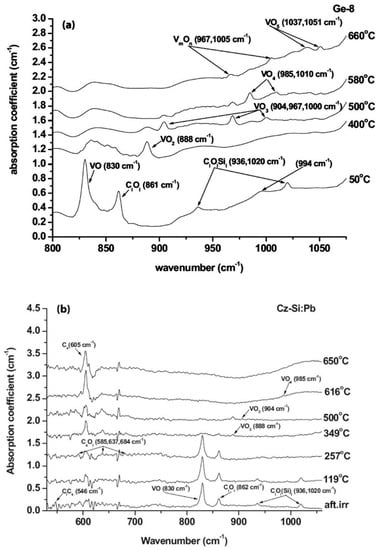
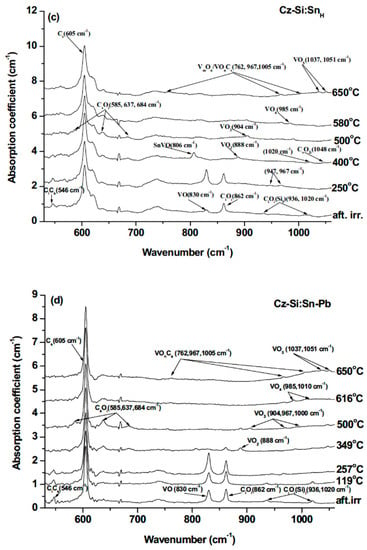
Figure 1.
IR spectra of the Ge-8 sample (a), after irradiation at a fluence of 5 × 1017 cm−2, and the Cz-Si:Pb (b), Cz-Si:SnH (c), and Cz–Si:SnPb (d) samples, after irradiation at a fluence of 1 × 1018 cm−2, at characteristic temperatures of the isochronal anneal sequence. Reproduced with permission from [,]. American Institute of Physics.

Table 1.
The Oi, Cs, Ge, Sn and Pb concentrations of the used samples for Figure 1 [,].
We will first consider oxygen-vacancy related defects.
Figure 2 (refer also to complementary Figures 2 and 3 of [,]) presents the evolution of the various VOn bands which appear in Figure 1. In the following, we shall mainly deal with the effect of isovalent dopants on the properties of the first two members of the VOn family of defects, that is, the VO and the VO2 centers.


Figure 2.
Thermal evolution of the various VOn defects for the Ge-8 sample (a), and the Cz–Si:Pb (b), Cz–Si:SnH (c), and Cz–Si:SnPb (d) samples. Reproduced with permission from [,]. American Institute of Physics.
2.1. Production of VO Defect as a Function of the Isovalent Dopant Covalent Radius
Figure 3 shows the production of the VO defect as a function of the isovalent dopant covalent radius. Information about the used samples is presented in Table 2. From Figure 3, taking the low carbon CL sample concentration as a base, we see that the sample doping with C and Ge results in an increase in the VO production, although doping with Sn and Pb results in a decrease in the VO concentration. More specifically, the following observations could be made.

Figure 3.
The production of the VO defects as a function of the isovalent dopant covalent radius Reproduced with permission from []. American Institute of Physics, 2012.

Table 2.
The concentrations of Ge, Sn, and Pb-doped samples, as well as the concentrations of the Oi and Cs of the used samples in Figure 3 [].
Regarding C, its ability to enhance VO production is due to its tendency [] to act as a preferential trap for self-interstitials, SiI’s. In the course of irradiation, V and SiI are produced. Most of them annihilate (V + SiI ➔ Ø). When Cs is present in the lattice, it competes with vacancies in capturing SiI (Cs + SiI ➔ Ci) and this leads to a decrease in the rate of the annihilation reaction. In other words, the availability of V increases, allowing the possibility for more vacancies to be captured by O atoms []. Equivalently, VO production is increased (compare the CL and CH samples in Figure 3).
Considering the Ge dopant, its tendency to act as an effective temporary trapping site for the V formed by the irradiation, restrains [] their direct annihilation by the SiI’s. In essence, the association of V with Ge leads to the formation of transient GeV pairs [] which are unstable above room temperature. This trapping and release of V by Ge atoms at T above room temperature, in essence, prevents some of the V to be annihilated by SiI’s. Equivalently, the number of available vacancies to be captured by O atoms increases, and, therefore, the VO production is enhanced. Since the Ge-doped sample contains an adequate amount of carbon, the final VO concentration is even higher than of the CH sample (Figure 3). Regarding the Sn dopant, in room temperature irradiation, SnV pairs are formed, which are stable at these temperatures [,]. In essence, Sn competes with O in capturing V, and as a result, the production of VO pairs decreases. SnV pair has no IR signal in the spectra and its presence is monitored [,,] in the spectra by the increase in VO signal as a result of SnV dissociation around 170 °C (Figure 2b,c). However, the final concentration of VO is smaller than of the CL sample (Figure 3). This indicates that some of the released V from the SnV dissociation participates in other reaction channels [], as, for instance, in the formation of the V2 defect.
Regarding the Pb dopant, the situation is similar to that of Sn. Indeed, due to the expected formation of PbV pairs, as a result of the competition between O and Pb in capturing V, in the course of room temperature irradiation, fewer VO are formed. Although no experimental evidence of the PbV pairs has been found so far, there are indirect indications for the formation of these defects in Pb-doping irradiated Si [,]. This is also supported by DFT calculations, which show that PbV pairs are highly bound []. Finally, the formation of VO pairs is substantially suppressed in the Pb-doped Si sample (refer to Figure 3).
2.2. Conversion of VO to VO2 Defect Versus Isovalent Dopant Covalent Radius
Figure 4 shows the conversion ratio (aVO2/aVO) of the VO to the VO2 defect as a function of the isovalent dopant covalent radius (information about the samples from Table 2). As seen in Figure 4, the larger the isovalent dopant radius, the smaller the conversion ratio. In other words, the formation of VO2 defects is more suppressed as the covalent radius of the isovalent dopant increases. This behavior could be explained [] as follows. The two main reactions that govern the annealing of the VO defect are: VO +Oi ➔ VO2 and VO + SiI ➔ Oi. Sources of the self-interstitials are large defect clusters [] formed in the irradiated material. As a result of the local strains induced in the Si lattice due to the substitutional incorporation of the larger radius isovalent dopants, the latter reaction is affected. It has been argued [] that the binding energy of the self-interstitials decreases as a result of the presence of the larger isovalent dopants. This makes the liberation of the self-interstitial from the defect clusters easier, facilitating their enhanced emission as the temperature increases in the course of annealing. It means that a larger number of VO pairs is dissociated due to the latter reaction, or an equivalently less VO participating in the former reaction. In other words, the formation of VO2 defects is suppressed. Thus, the larger isovalent radius, the smaller the VO2 formation. This is represented in Figure 4. Next, we shall study the production and evolution of the VO defect as a function of the Ge dopant concentration in Si.
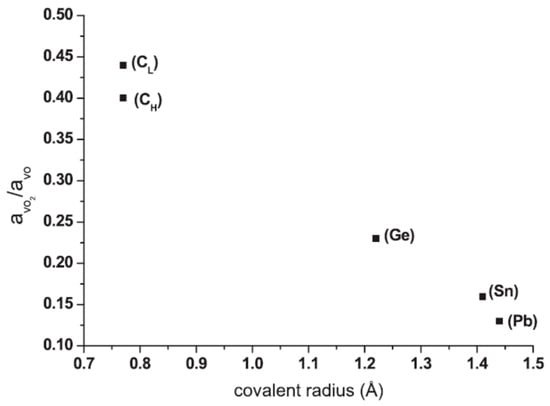
Figure 4.
The conversion ratio aVO2/aVO of the VO to VO2 defect as a function of the isovalent dopant covalent radius Reproduced with permission from []. American Institute of Physics 2012.
2.3. Production of VO Defects Versus Ge Dopant Concentration
Figure 5 shows the production of the VO defect as a function of the Ge dopant concentration in the Si samples. As seen in Table 3, we used samples with Ge concentrations in the range 1 × 1017–2 × 1020 cm−3. Since the concentration of Cs in the samples also varies, and as it is known that C affects the production of VO, as we shall discuss later, we divided the samples into three groups. Samples with a low initial Cs concentration smaller than 2 × 1016 cm−3, such as the samples Cz-Si0, Ge-2 and Ge-6, labeled as carbon-lean samples, formed group I. Next, samples Ge-1, Ge-3, Ge-4 and Ge-7, with an initial Cs concentration in the range of 2 × 1016–1 × 1017 cm−3, labeled as carbon-moderate doped samples, formed group II. Finally, samples Ge-5 and Ge-8, with an initial Cs concentration around 2 × 1017 cm−3, labeled as carbon-rich doped samples, formed group III. Regarding group I, we observed in Figure 5 an increase in VO concentration as Ge concentration increased. At first, as we mentioned above, Ge dopant acted as a temporary trap of V in the course of irradiation, and, thus, increased the VO concentration. Apparently, the larger the Ge concentration, the larger the availability of V, thus the larger the VO concentration. This explains the observed VO versus Ge curve for C-lean samples in Figure 5. Regarding group II, we had, in addition, the effect of C on VO production. As we also mentioned above, the latter impurity acted as a trap for the self-interstitials produced by irradiation, thus suppressed their annihilation with the vacancies. This behavior of C increased the availability of V and consequently, further enhanced the production of VO defect. As a result, the production curve of VO in C-moderate samples had a similar behavior to C-lean samples, but it was replaced at higher VO concentration, as depicted in Figure 5. Regarding group III, a reduction in VO was observed for sample Ge-8 with a high Ge concentration of 2 × 1020 cm−3, in comparison with sample Ge-5 with a Ge concentration of 1 × 1019 cm−3. Earlier photoluminescence studies have shown [] that the presence of Ge in such concentrations causes changes in the spectra which are attributed to the inhomogeneous distributions of Ge atoms and the appearance of Ge clusters. The induced strains in the lattice lead to the trapping of V and SiI’s in these clusters, facilitating their mutual annihilation. Thus, the availability of V produced by irradiation is reduced, which leads to a decrease in the VO defects []. Apparently, the higher the Ge concentration, the larger the VO decrease, as depicted in Figure 5 for the two samples Ge-5 and Ge-8.
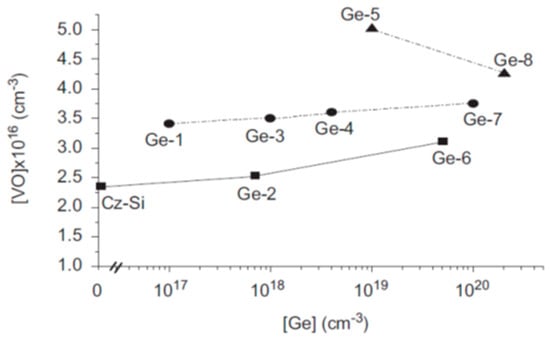
Figure 5.
The production of the VO defect as a function of the Ge dopant concentration in the Si samples. Reproduced with permission from []. Elsevier, 2009.

Table 3.
The concentrations of Ge, Oi and Cs of the Cz–Si:Ge samples used in Figure 5 [,].
2.4. Conversion of VO to VO2 Defect Versus Ge Dopant Concentration
Figure 6 shows the conversion ratio (aVO2/aVO) of the VO to VO2 defect as a function of the Ge dopant concentration (information about the samples from Table 3). As observed, the ratio (aVO2/aVO) decreases with the increase in Ge content. This effect is attributed [] to the influence of Ge on the main reactions that govern the annealing of VO pair, that is: VO + Oi ➔ VO2 and VO + SiI ➔ Oi. As mentioned above, the sources of the self-interstitials are large defect clusters [] formed in the course of irradiation. It has been argued [] that the strains introduced into the Si lattice due to the presence of Ge facilitates the liberation of SiI’s from the clusters, thus enhances the reaction VO + SiI ➔ Oi and, therefore, suppresses the reaction VO + Oi➔ VO2, since less VO are available for the latter reaction. In essence, this leads to a decrease in the formation of VO2 defect which is manifested by the decrease in the (aVO2/aVO) ratio. Notably, due to the temporary trapping of V by Ge atoms in the course of irradiation, the annihilation rate between vacancies and self-interstitials in the course of irradiation is reduced, which increases the availability of SiI’s and, therefore, increases the reaction VO + SiI ➔ Oi. In fact, the latter reaction is the main reason for the partial transformation of VO pairs to VO2 defects. Importantly, the behavior of the ratio (aVO2/aVO) is similar for the LC and the HC material (compare Figure 6a,b). Additionally, in the case of high Ge content, there is a slight increase in the (aVO2/aVO) ratio in both samples. This is related with the fact that the introduction of Ge in very large concentrations in the Si lattice leads [] to the inhomogeneous distributions of Ge atoms, which generally affects [] the balance between the reactions VO + Oi ➔ VO2 and VO + SiI ➔ Oi, which mainly govern the VO to VO2 transformation. This change may be reflected in the slight increase in the (aVO2/aVO) ratio in the high Ge concentration samples, as observed in Figure 6.

Figure 6.
The conversion ratio (aVO2/aVO) of the VO to VO2 defect as a function of the Ge dopant concentration in the Si samples []. (a) Low concentration (LC) and (b) high concentration (HC) material. Reproduced with permission from []. American Institute of Physics, 2011.
2.5. The Effect of the Ge Dopant Concentration on the Tann of the VO and the Tform of the VO2 Defects
Figure 7 and Figure 8 show the characteristic temperatures Tann of the VO annealing and Tform of the VO2 formation as a function of the Ge concentration (information about the samples from Table 3). It was observed that the annealing temperature Tann of VO (Figure 7) and the consequent formation temperature Tform of VO2 (Figure 8) decreased as the Ge concentration in the samples increased. The phenomenon can be explained as follows. In Ge-doped Si, the reaction VO + SiI ➔ Oi involved in the VO annealing is enhanced []. Indeed, the presence of Ge facilitates the emission of SiI’s from loosely bound self-interstitial clusters. This promotes an earlier onset of VO annealing’ that is, the earlier annealing of the VO defect is mainly due to the reaction VO + SiI ➔ Oi, which is activated earlier in the Si lattice due to the Ge presence. The larger the Ge concentration the earlier the onset of the VO annealing. Regarding the now earlier growth of the VO2 defect in the spectra, the following explanation can be offered []. It is established [,] that divacancies V2, which also form during irradiation, can partly anneal out by dissociation (V2➔V +V) in the temperature range 250–300 °C, releasing isolated vacancies. These vacancies are mobile at the above temperatures, and it is very likely that they encounter Oi atoms released from the reaction VO + SiI ➔ Oi to form VO pairs. These VO atoms can be responsible for the enhanced formation of VO2 defects forming when the mobile VO pairs are captured by isolated oxygen atoms. The activation of this scheme of reactions could finally explain the growth of VO2 defects at earlier temperatures. Additionally, we argued [] previously that Ge atoms act as a temporary trap for vacancies. This trapping and release of V by Ge helps them to survive longer in the lattice, thus increasing the possibility of encountering oxygen atoms and being captured by them. This, in turn, could lead to the formation of VO2 defects at lower temperatures.
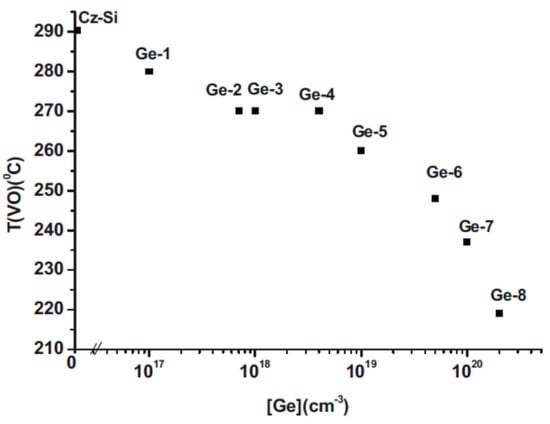
Figure 7.
Annealing temperature of VO defects as a function of Ge dopant concentration. Reproduced with permission from []. American Institute of Physics, 2010.
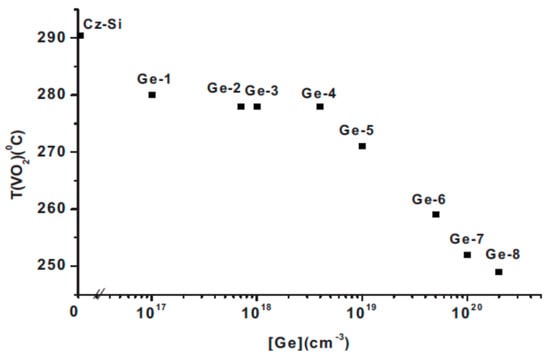
Figure 8.
Formation temperature of VO2 defects as a function of Ge dopant concentration. Reproduced with permission from []. American Institute of Physics, 2010.
2.6. Production of VO Defect Versus C Concentration
Figure 9 shows the production of the VO defect as a function of the Cs concentration of the samples (data from Table 4). It was observed that VO production increased as the C concentration of the samples increased. Three groups of samples irradiated with 2 MeV electrons, at three different fluencies, were used. The first group contained four samples of S1i (i = 1–4) irradiated at 5 × 1017 cm−2, the second group contained three samples of S2i (i = 1–3) irradiated at 1 × 1018 cm−2, and the third group contained two samples of S3i (i = 1–2) irradiated at 2 × 1018 cm−2. In the presence of C, there are three main reactions that take place in the Si lattice in the course of irradiation: V + SiI ➔ Ø (annihilation), V + O ➔ VO, and Cs + SiI ➔ Ci. The tendency of C to trap SiI’s leads to a decrease in the rate of annihilation of V, which enhances [] the number of available V to be captured by O atoms. In other words, the formation of VO defects is enhanced. This was observed in the three groups of samples irradiated with three different fluencies as illustrated in the three curves of Figure 9.
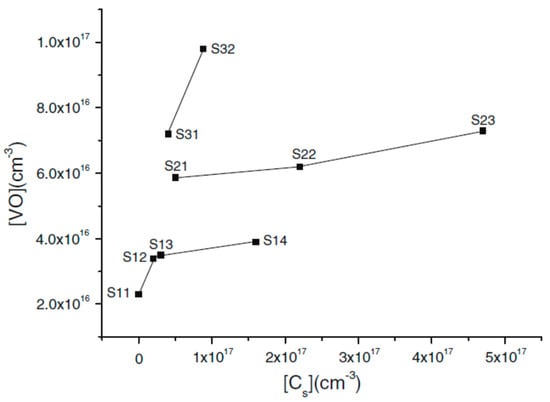
Figure 9.
The production of VO defects as a function of carbon concentration for various fluencies. Reproduced with permission from [].

Table 4.
Initial concentrations of Oi and Cs, as well as the VO concentration, and the ratio aVO2/aVO for the samples used, irradiated with 2 MeV electrons at various fluencies [].
2.7. Conversion of VO to VO2 Defect Versus C Concentration
Figure 10 shows the conversion ratio (aVO2/aVO) of VO to VO2 defects as a function of the C concentration (data from Table 4). As seen in Figure 10, the conversion ratio (aVO2/aVO) decreased with the increase in the C content of the samples. As discussed in relation to Figure 9 above, the formation of VO2 defect was suppressed as a result of the presence of isovalent dopants in the Si lattice; in particular, the larger the isovalent dopant radius, the smaller the corresponding (aVO2/aVO) ratio. In essence, the phenomenon is attributed to the fact that isovalent dopants affect [] the balance between the two main reactions, VO + Oi ➔ VO2 and V + SiI ➔ Ø, that govern the annealing of the VO pair. The suppression of VO2 formation is smallest in the case of carbon (see Figure 4), which is the element with the smallest covalent radius among the isovalent dopants. More specifically, in the case of carbon, DFT calculations have shown [] that carbon could be trapped by VO pairs to form a CsVO defect which suppresses the VO2 formation reaction VO + Oi ➔ VO2. The larger the C concentration, the lower the VO2 production, and, therefore, the lower the (aVO2/aVO) ratio, as observed in Figure 10 for the three curves corresponding to the three different irradiation fluences. To complete the picture, it should be noted that it is also possible [] that some VO pairs may be missed due to their capture by some IR inactive sinks which may be activated by the presence of the C impurity. Importantly, it has been found [] that more than half of the formed VO pairs are not transformed into VO2 defects. The fate of the missed VO is still an unanswered question. It means that other reaction channels control the fate of VO pairs, a subject which needs further investigation. Further, we shall consider VnO defects, mainly with the V2O and V3O members of this family.
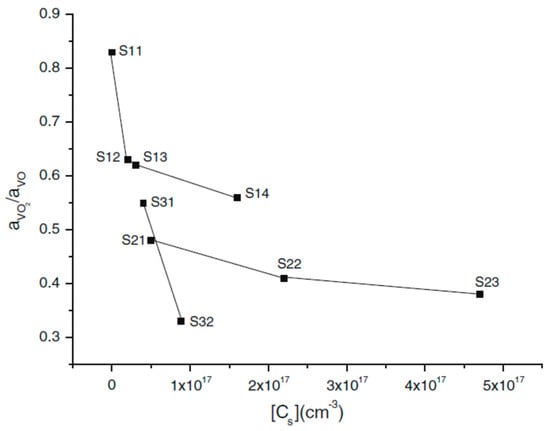
Figure 10.
The conversion of the VO to VO2 defect as a function of the C concentration in the Si samples. Reproduced with permission from [].
Figure 11 displays the Lorentzian profiles of the IR spectra in the frequency range of the VO defect in the case of CL(a), Ge(b), Sn(c) and Pb(d) samples, respectively, (information about the samples from Table 2), for two characteristic temperatures of 151 and 323 °C. As seen from Figure 11, in addition to the 830 cm−1 band of VO pair, bands at ~826 and ~839 cm−1 which were attributed [,] to the V2O and V3O centers, respectively, could be separated in the profiles. The band at ~835 cm−1, also noted in the Lorentzian profiles, is probably related with the VmOn structure, but its exact identity is not known. Notably, V2O and V3O defects at 10 K have [,] IR bands at 833 and 842 cm−1, respectively.

Figure 11.
Deconvolution of the VO defect spectral region of the IR bands into Lorentzian profiles for the samples (CL) (a), (Ge) (b), (Sn) (c), and (Pb) (d). Reproduced with permission from []. American Institute of Physics, 2012.
Figure 12 shows the amplitudes of the V2O and the V3O defects, respectively, as a function of the covalent radius of the isovalent dopants for the samples spectra shown in Figure 11. Regarding the V2O defect, taking the CL material as a basis, which can practically be considered as a simple Cz–Si sample without a C dopant, we observed that for the Ge, Sn and Pb-doped samples, the larger the covalent radius, the smaller the production of the V2O defect. The main reactions for the formation of the V2O defect are VO + V ➔ V2O and V2 + O ➔ V2O. The observed behavior may be attributed [] to the ability of isovalent dopants to compete with O in capturing vacancies in the course of irradiation. In the case of Ge, the formation of transient GeV pairs which dissociate at room temperature increase the availability of vacancies, thus facilitating the production of more VO pairs, which finally lead to more V2O defects, mainly through the reaction VO + V ➔ V2O. This mechanism did not occur for the Sn and Pb doped samples. Indeed, the availability of V was decreased in the latter samples due to the formation of SnV and PbV pairs which are stable at room temperature. Thus, the production of V2O defects was suppressed in the Sn and Pb-doped samples. Apparently, the contribution of the reaction V2 + O ➔ V2O did not seem to alter the balance between the two reactions among the above three dopants, to change the order of V2O defect production versus the isovalent dopant radius, as depicted in Figure 12a. It should be stressed, that in the case of the CH sample, the tendency of C to react readily with self-interstitials, in contrast with the other three dopants, led to the suppression of the V2O defect in comparison with the CL sample, as seen in Figure 12a. Regarding the V3O defect, the main reactions for its formation are V2O + V ➔ V3O and V2 + VO ➔ V3O. Unfortunately, the relative results provided in Figure 11 were not enough to reach firm conclusions. For instance, the V3O band at 839 cm−1 only appeared in a few temperatures around 300 °C in the Lorennzian profiles of the Sn-doped sample, and its evolution could not be depicted properly, as seen in Figure 7 of []. Nevertheless, some points can be formed. Namely, in the case of Ge-doped Si samples, the production of V3O was larger in comparison with the C and Pb-doped samples. The enhancement production of V3O has been attributed to the enhancement of the reaction V2O + V ➔ V3O due to the increased availability [] of VO and V2 defects in Ge-doped Si. Additionally, due to the recombination of V2 by the self-interstitials (V2 + SiI’s ➔V) the liberated vacancies promote [] the reaction V2O + V ➔ V3O which leads to a further increase in V3O defects. In the case of C-doped samples, the reaction V2 + SiI’s ➔ V is substantially suppressed due to the tendency of C to trap SiI’s (Cs + SiI’s ➔ Ci) which suppresses availability of V, as in the case of Ge-doped Si. This leads to a lower production of V3O defects. In the case of Pb-doped Si, on one hand the production of VO and V2O is small, but on the other hand, any liberation of V is limited, resulting in a suppression of the two formation reactions of the V3O defects mentioned above. This leads, therefore, to their even smaller production. Notably, our Pb-doped Si also contained carbon in high concentration, which limited the number of available V which may have participated in reactions which favored the formation of V3O defects.
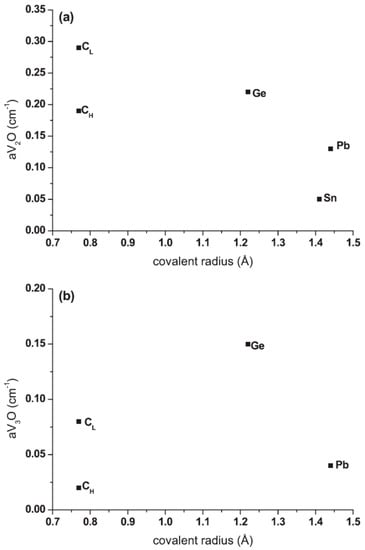
Figure 12.
(a) The amplitudes of the V2O defect as a function of the isovalent dopant covalent radius of the Si sample, and (b) the amplitudes of the V3O defect as a function of the isovalent dopant covalent radius of the Si. Reproduced with permission from []. American Institute of Physics, 2012.
In our previous work, DFT calculations were employed to calculate the relative energetics of the A-center and its interaction with isovalent dopants. Figure 13a illustrates the VO that is essentially formed from the binding of an Oi atom next to V in Si (binding energy −1.32 to 1.57 eV, [] and references therein). In the vicinity of an isovalent dopant, VO pairs preferentially bind at nearest neighbor positions (Figure 13b,d) as compared with next nearest neighbor positions (Figure 13c,e). The binding energy gain of the isovalent atom in nearest neighbor position to the vacancy (in the VO) is considerably higher due to the strong binding (mainly relaxation) of the dopant atoms (particularly due to the relaxation of oversized atoms such Sn and Pb) to the vacant site []. The DFT results show that the incorporation of isovalent dopants in Si led to the formation of DVO or DOV clusters. These formed as they reduced the repulsive NN interactions of the isovalent atoms with the oxygen interstitials [].

Figure 13.
An illustration of the minimum energy structure of (a) the VO (A-center), (b) the nearest neighbor 𝐷VO, (c) the next nearest neighbor 𝐷VO, (d) the nearest neighbor 𝐷OV, and (e) the next nearest neighbor 𝐷OV defects. Yellow and gray spheres indicate the Si and 𝐷 atoms, respectively, whereas Oi are represented by the red spheres, and the vacant site by the black sticks. Reprinted with permission from []. American Institute of Physics, 2010.
Apart from energetics, DFT calculations can provide detailed information on the structure of the defects. For example, in previous work [] the optimized structures for the GeVO, SnVO, PbVO, GeV, SnV, and PbV defects in Si were given (refer to Figure 14). These studies indicated that the oversized isovalent dopants (Sn or Pb) preferentially occupy the space between two semi-vacant lattice sites (i.e., the split–vacancy configuration) []. Nevertheless, when an Oi is present in the defect, it effectively prevents the Sn (or Pb) to shift towards the vacant site [].
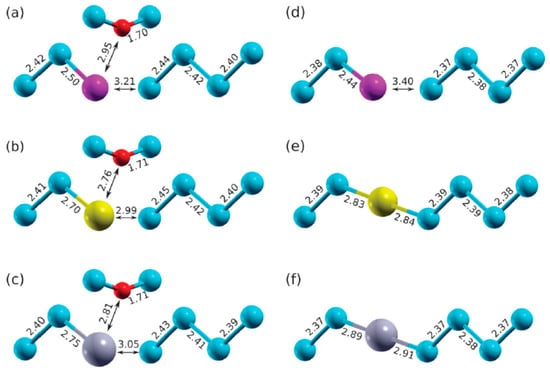
Figure 14.
The isovalent dopant—VO interactions along the (10-1) direction: (a) GeVO, (b) SnVO, (c) PbVO, (d) GeV, (e) SnV, and (f) PbV. Larger spheres represent the isovalent dopant, blue spheres the Si atoms, and red spheres the Oi atoms. All the distances are in Å. Reprinted with permission from the PCCP Owner Societies, [].
DFT calculations can be used to provide complementary information on the thermal evolution of defects. The thermal evolution of defects and their relative concentration is important to understand the defects that are bound to form in different conditions. Experimental work is key in that respect, but DFT studies can be used to provide complementary information on whether specific defects will form and their exact configurations. For example, the different defect configurations are given at the top of Figure 15, whereas the FTIR experimental results indicate their thermal evolution [].
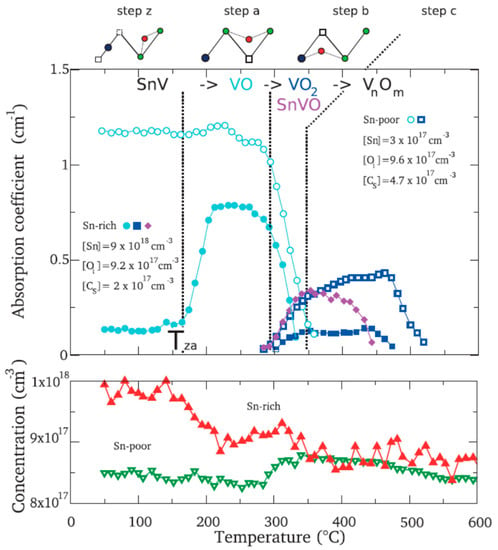
Figure 15.
The thermal evolution of the A-center, VO2, and SnVO defects for samples with Sn-poor content and Sn-rich content. The constituent defects are sketched using red circles for the oxygen atoms, blue and green circles for the D and Si atoms, respectively. The square and dotted square represent the V and semi-vacancies. The thermal evolutions of the Oi for Sn-poor and Sn-rich concentrations are given at the bottom of the figure Reprinted with permission from []. American Institute of Physics, 2011.
In the following part we will consider carbon-related defects.
Carbon is the second most important impurity, besides oxygen, unintentionally added into the Si lattice during growth. Its presence in the monocrystalline Si originates mainly from polycrystalline material during processing [] with various chemicals such as ethylchlorosilanes. The mechanisms of C incorporation into Si and its distribution in the lattice has been studied in detail in previous studies [,,]. Carbon as an isovalent impurity is substitutionally dissolved in the Si lattice, Cs, and interacts with oxygen, forming various CsOi complexes during growth. Carbon has a covalent radius smaller than Si and the tensile strains introduced into the lattice by its presence is relieved with the capture of self-interstitials. Upon irradiation, carbon readily captures self-interstitials converted to carbon interstitial, Ci (Cs + SiI ➔ Ci). In the latter form, carbon is very mobile even at room temperatures, and reacts strongly with Oi and Cs leading to the formation of CiOi and CiCs pairs, respectively, which are the main C-related defects formed. On heavier irradiation, CiOi(SiI), CiCs(SiI), and Ci(SiI) complexes are also formed [], as are even higher members of the families CiOi(SiI)n and CiCs(SiI)n, as well as Ci(SiI)n. There are theoretical predictions [] for the existence of CsV defects but there is no positive experimental evidence so far that carbon captures vacancies. The IR signals from the above families are very low, and it is difficult to reach established conclusions. It needs samples with high C, Ge, Sn and Pb content to be irradiated at very large fluencies in order to have measurements for comparison purposes. This is scheduled for a future experiment. In the present work, in terms of the C-related defects, we mainly concentrated on CiOi and CiCs pairs.
We additionally note that in [] (in Figure 7 in particular) we compared, measurements for the CiOi(SiI) complex between SnH and Snl in Si-doped material. We have not included this information in the present work since we also need comparisons with Ge-doped and Pb-doped Si to achieve a clear picture for the behavior of this defect.
Figure 16 presents [] the IR spectra of Si for the S22 sample after irradiation and at certain characteristic temperatures in the course of isochronal anneals (data from Table 4). Sample S22 was a Cz–Si sample without any isovalent dopant and was irradiated at a fluence of 1 × 1018 cm−2. Signals from various O-related and C-related defects were present. From the latter family we shall focus mainly on CiOi (862, 739 cm−1) and CiCs (546 cm−1) defects. Signals from CsOi (585, 637, 684 cm−1) and CiOi (SiI) (936, 1020 cm−1) defects also appeared, as well as a band at 1048 cm−1 attributed to the CsO2i defect. Notably, Figure 16 was given to complete Figure 1b reporting respective spectra of isovalent-doped Si samples.
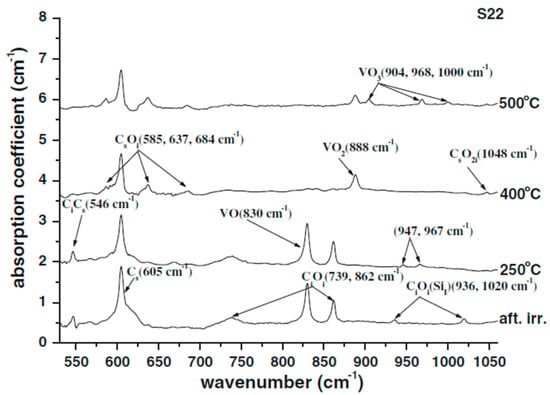
Figure 16.
IR spectra of the S22 sample after irradiation and at characteristic temperatures in the course of the isochronal anneals. Reproduced with permission from [].
Figure 17 shows the production of CiOi defect as a function of the covalent radius of the isovalent dopants for some representative samples (data from Table 5). As the initial carbon concentration was not the same in the various isovalent-doped samples, it was difficult to extract safe conclusions about the effect of different dopants on the production of the CiOi defect. However, certain observations could be made. For instance, the CiOi concentration was largely suppressed in the Pb-doped Si sample. This may be related to the tendency of Pb dopant in Si to pair with C and form PbC complexes [,,]. In such a case, the available C to pair with O is reduced, leading to a decrease in the CiOi concentration. Regarding Sn-doped Si, although SnC defects have been reported [,] it has been suggested [] that the coexistence of Sn and C in the silicon lattice could lead to a suppression of the CiOi production when the Sn concentration increases. Regarding Ge-doped Si, although theoretical calculations have shown that GeC complexes could be formed [], it has also been found experimentally [] that in the case of Ge and C coexistence, the formation of CiOi pairs tends to increase with the increase in the Ge content of the material. A final note: in the case of CH, SnH and Pb samples with about similar C concentrations, the formation of CiOi, as seen in Figure 17 was larger in the SnH sample and substantially smaller in the Pb sample, in comparison with the Ge-doped sample.
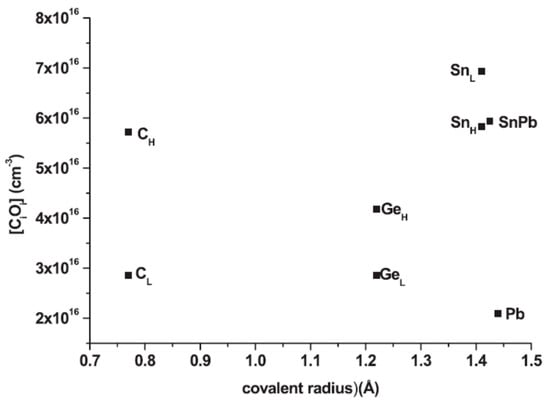
Figure 17.
The production of CiOi defect as a function of isovalent dopant covalent radius. Reproduced with permission from []. American Institute of Physics, 2013.

Table 5.
Initial concentrations of Oi and Cs, as well as those of VO, CiOi concentrations and the ratio aCsO2i/aCiOi for the samples used, irradiated with 2 MeV electrons at various fluencies [].
Figure 18 presents the annealing behavior of CiOi, for various isovalent dopants, together with the evolution of a band at 1048 cm−1 arising in the spectra upon the annealing out of the CiOi. The latter band has been attributed [] to a CsO2i structure. The CiOi defect anneals out [,,,] either by destruction (CiOi ➔ Ci + Oi) or by interaction with another defect, as, for instance, in our case, the VO defect. In the former case, the produced Ci reaction with VO2 defects leads [] to the formation of the CsO2i structure (Ci + VO2 ➔ CsO2i). In the latter case, VO and CiOi pairs react to form [,] CsO2i.
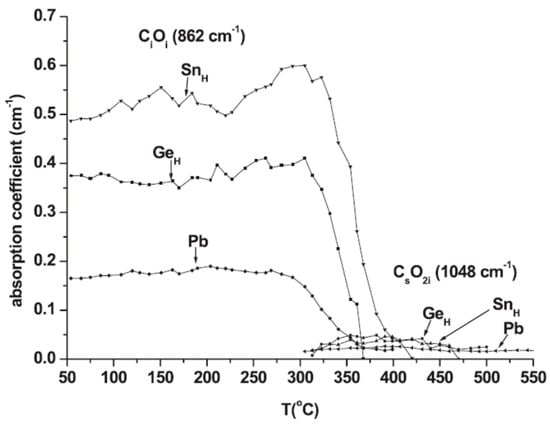
Figure 18.
The annealing behavior of CiOi and CsO2i defects for various isovalent dopants. Reproduced with permission from []. American Institute of Physics, 2013.
Figure 19 presents the conversion ratio of the CiOi to CsO2i defect for various isovalent dopants (data from Table 5). Given the different C concentrations of the samples it is not prudent to reach a final conclusion. A comment could be made possibly only in the case of SnH and Pb doped Si samples, with about the same C content []. It seems that the conversion ratio is larger in the Pb-doped sample than in the SnH-doped sample. Possibly, the amount of C that binds with Sn is different than that which binds with Pb, and some of the reactions in which C participates, in the course of anneals, are also different between the two materials. This is reflected in the corresponding conversion rates of CiOi to CsO2i. More experimental data are necessary to clarify the picture.
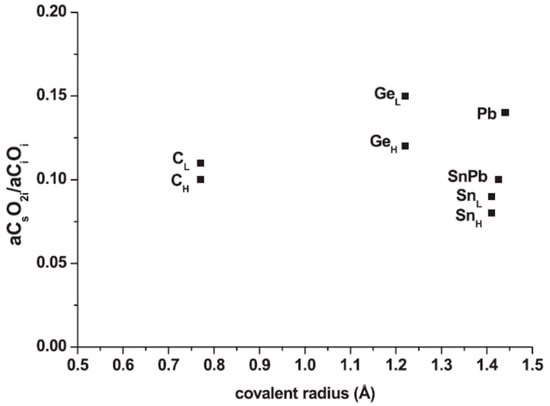
Figure 19.
The conversion ratio of the CiOi to CsO2i defect for various isovalent dopants. Reproduced with permission from []. American Institute of Physics, 2013.
Figure 20 presents the evolution with temperature of the CiOi defect in Si for various isovalent dopants (data from Table 6). In this figure, spectra of pairs of samples such as (GeL, GeH) (SnL, SnH), as well as (Pb, SnPb), are compared. The CiOi for a Cz–Si sample is also given.

Figure 20.
Evolution with temperature of the CiOi defect for various isovalent dopants. For (a) Cz-Si, (b) SnL and SnH, (c) SnPb and Pb, and (d) GeL and GeH Si samples. Reproduced with permission from [].

Table 6.
Initial concentrations of Oi and Cs impurities and the CiOi and CiCs concentrations for the samples used, irradiated with 2 MeV electrons, as well as the respective fluencies for each sample [].
Figure 21 shows the respective evolutions of the CiCs defect for the same pairs of isovalent doped samples (data from Table 6) as Figure 20. Prior to comparing the annealing characteristics of CiOi and CiCs centers, a comment for the latter is needed. The CiCs anneals out at around 350 °C. No signal arises in the IR spectra upon the disappearance of the CiCs defect. It is important to note that the thermal annealing of the dicarbon center is uncertain [,] and is not completely understood. Although destruction is the main annealing mechanism, photoluminescence (PL) studies [] have shown that the dicarbon center may also capture a mobile atom to form another center responsible for the 7686 cm−1 line growing in the PL spectra as the G line of the CiCs center decay. The origin of the latter line is not certain [].
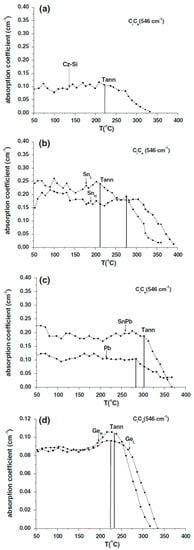
Figure 21.
Evolution with temperature of the CiCs defect for various isovalent dopants. For (a) Cz-Si, (b) SnL and SnH, (c) SnPb and Pb, and (d) GeL and GeH Si samples. Reproduced with permission from [].
Comparing Figure 20 and Figure 21, we observed that the annealing temperature Tann of both of the CiOi and CiCs centers was slightly affected, depending not only on the isovalent dopant covalent radius but also on the concentration of the isovalent dopant in the Si material. These small variations of Tann for the samples in Table 6 are clearly illustrated in Figure 22. Taking as a reference point the Tann of a Cz–Si sample, the main finding, as clearly seen comparing Figure 22a, for CiOi, and Figure 22b, for CiCs, is that isovalent dopants differently affect the Tann. More specifically, as a general characteristic, the annealing temperature decreased in the case of CiOi, although it increased in the case of CiCs. Both CiOi and CiCs annealed out mainly [] by dissociation expressed, respectively, by the reactions (CiOi ➔ Ci +Oi) and (CiCs➔Ci +Cs). In essence, the Tann represents the temperature at which the centers break up. In the case of isovalent dopants it can be reasonably surmised [] that the effect of their presence on the Tann is mainly related to the difference in the strains introduced into the Si lattice by the dopants, due to their different magnitudes. The introduction of larger isovalent dopants is expected to affect the strength of the bonds in the CiOi and CiCs structures. The activation energy, Ea, characterizing the energy necessary for the pair to dissociate, can be expressed by the relation Ea = Ef + Eb, where Ef represents the formation energy of the pair, and Eb its binding energy. It was argued [] that the binding energy, Eb, is affected by the local strains introduced into the lattice by the isovalent dopants. The structure [] of CiOi comprises a Ci slighted disturbed from its isolated configuration, which pairs with an Oi atom. On the other hand, CiCs can exist in two configurations [,], A and B. In heavily electron irradiated Si, the defect is expected to be in the B configuration, where a bond-centered Si atom lies between two Cs atoms. From the results of Figure 22, it may be concluded that the induced strains from the presence of the isovalent dopants reduce the Eb of the CiOi structure, although they increase the Eb of the CiCs structure. In other words, the activation energy of CiOi becomes smaller, although for CiCs it becomes larger. This is manifested in the observed decrease in Tann of CiOi and the observed increase in Tann of CiCs.
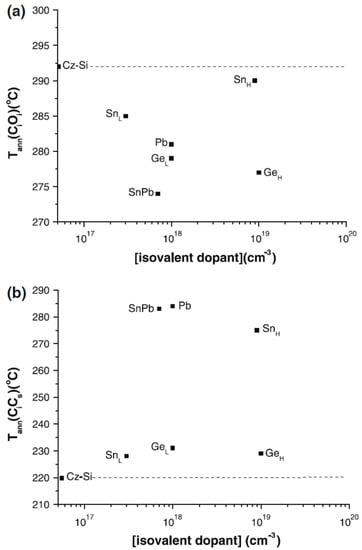
Figure 22.
The annealing temperature Tann of CiOi (a), and CiCs (b), pairs versus the covalent radius of the isovalent dopants. Reproduced with permission from [].
The production of the CiOi defect as a function of Ge concentration has been given in previous work (refer to Figure 3 of [] and/information about the samples from Table 3). In Figure 3, the variation of the CiOi defect is shown together with the variation of VO, for comparison purposes. For the moderate-doped samples Ge-1, Ge-3, Ge-4 and Ge-7, the two defects showed a similar behavior. Their concentration increased with the increase in Ge concentration. This can [] be attributed to the tendency of Ge to trap vacancies temporarily in the course of irradiation, preventing their annihilation with self-interstitial atoms. On one hand, these vacancies, when liberated by the dissociation of the GeV pairs, are readily captured by oxygen atoms, thus enhancing the VO production. On the other hand, the self-interstitials are readily captured by Cs to turn them into Ci. Next, the Ci atoms combine with oxygen atoms to form CiOi pairs, thus enhancing the production of the latter defect. For carbon-rich samples Ge-5 and Ge-8, the two defects again showed similar behavior. However, their concentration decreased as Ge concentration increased, showing an opposite trend to the carbon-moderate samples. This behavior occurring at high Ge concentrations could be attributed [] to the inhomogeneous distributions of Ge atoms in the Si lattice which lead to the formation of Ge clusters. The associated strain fields assist the trapping of vacancies and self-interstitials in their territory, leading, finally, to a decrease in the formation of VO and CiOi pairs, as observed in our spectra.
Figure 23 and Figure 24 show the evolution with T of the CiOi and CiCs defects, respectively, as a function of Ge concentration of some characteristic samples such as the Ge-3, Ge-5 and Ge-8 (information about the samples from Table 3). It seemed that the Ge presence did not affect the Tann of the samples. This is clearly manifested in Figure 25 and Figure 26 (information about the samples from Table 3) where only negligible changes are observed. Since the covalent radius of Ge (rGe = 1.22 Å) is slightly different to that of Si (rSi = 1.17 Å), one may think that the differences in the induced strains are not sufficient [] to causes changes in the Tann of the Si samples with various Ge concentrations.
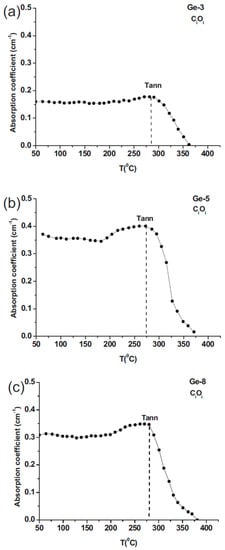
Figure 23.
The evolution with T of the CiOi defect as a function of the Ge dopant concentration for the characteristic (a) Ge-3, (b) Ge-5, and (c) Ge-8 samples. Reproduced with permission from []. American Institute of Physics, 2010.
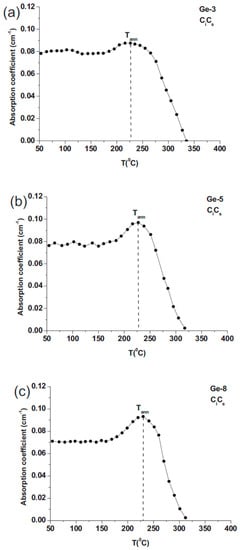
Figure 24.
The evolution with T of the CiCs defect as a function of the Ge concentration for the (a) Ge-3, (b) Ge-5, and (c) Ge-8 samples. Reproduced with permission from []. American Institute of Physics, 2010.
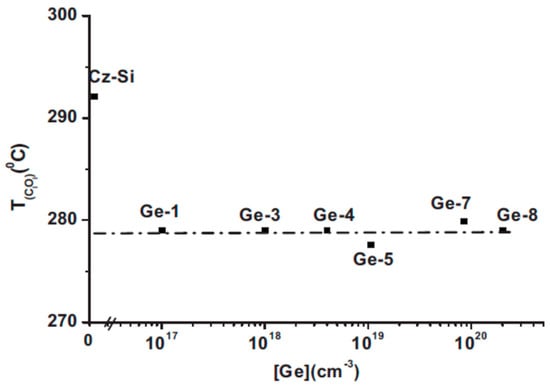
Figure 25.
The annealing temperature Tann of the CiOi defect as a function of the Ge concentration Reproduced with permission from []. American Institute of Physics, 2010.
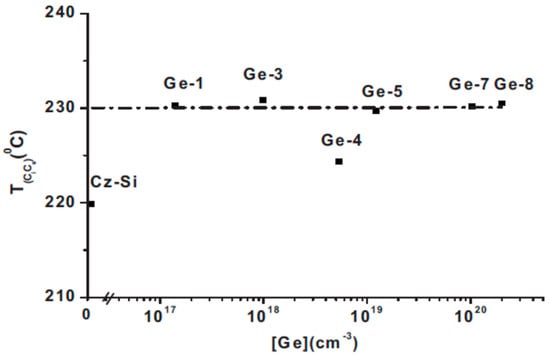
Figure 26.
The annealing temperature Tann of the CiCs defect as a function of the Ge concentration Reproduced with permission from []. American Institute of Physics, 2010.
As C is an important impurity in Cs–Si, the minimum energy structures of C-related defects have been investigated in detail. Figure 27 represents the structures of the main defects containing Ci, Cs, Oi and SiI. In the Ci(SiI) defect (refer to Figure 27a) the Si–C dumbbell shares the interstitial site, whereas the Si atoms surrounding the defect are from their lattice sites []. In this defect, the C is threefold coordinated []. Figure 27b represents the CiOi defect where the C and O interstitials essentially form a ring with Si, ([] and references therein). The three stable configurations of the CiCs defect are given in Figure 27e–g. In this defect, the C-type configuration was demonstrated by DFT to be the lowest energy configuration, whereas in previous studies, the C-type configuration was established for a long time ([] and references therein). Finally, Backlund and Estreicher [] proposed the two configurations of CiOi(SiI) (refer to Figure 27c,d); these can be distinguished by the SiI with respect to the CiOi pair [].
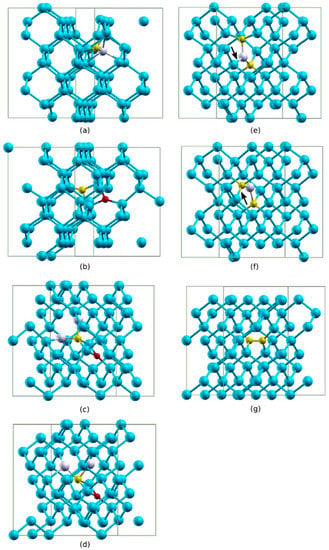
Figure 27.
DFT-derived minimum energy structures for carbon related defects: (a) Ci (SiI), (b) CiOi, (c) CiOi(SiI)a, (d) CiOi(SiI)b, (e) A-type CiCs, (f) B-type CiCs, and (g) C-type CiCs. The blue spheres represent the Si atoms, yellow spheres represent the C atoms, and red spheres represent the O atoms Reproduced with permission from [].
3. Summary and Future Directions
The effect of isovalent dopants on the properties of radiation defects in silicon has been investigated for numerous years in order to defect-engineer silicon and enhance its functionality for electronic devices. The present review focused on the effect of isovalent dopants on oxygen-related (mainly VO and VO2 centers) and carbon-related (mainly CiOi and CiCs centers) defects in irradiated Si. Regarding oxygen-vacancy centers, it was previously determined that isovalent dopants affect the production of VO defect and its conversion to VO2 defect. More specifically, the experiments showed that the presence of Ge and C enhanced VO production, although the presence of Sn and Pb suppressed it. Concerning the conversion of VO to VO2, it was determined that the larger the covalent radius of the dopant, the less VO2 formed. Studying specifically the effect of C, it was concluded that VO2 decreased as the concentration of C increased. Additionally, the thermal stability of VO andVO2 defects was affected.
Regarding carbon-related centers, it was determined that the presence of Pb substantially suppressed the production of CiOi and CiCs pairs. The same effect occurred for Sn and Ge. However, the respective effect of Ge and Sn seemed to be more complicated, depending on the concentration of the latter two dopants and the C content of the material. The conversion of CiOi to the CsO2i complex was slightly affected by the isovalent dopants. The experiments showed that the presence of Ge and Pb slightly enhanced CsO2i formation, although Sn reduced it slightly. The thermal stability of the CiOi pair was less affected by the isovalent dopants in comparison with the VO defect. Specifically, the effect of Ge was almost negligible. Importantly it was found that isovalent dopants differently affected the thermal stability of the CiOi and CiCs pairs. The Tann of the CiOi pair was reduced, although the Tann of the CiCs pair was increased.
Thus, an assessment of the hardening potential of the isovalent impurities in Si regarding the radiation defects was performed. It was demonstrated that the formation of O-related and C-related defects was suppressed in Si material. This allows the enhancement of radiation hardness of Si-based devices operated in radiation environments, as, for instance, radiation detectors and devices for aerospace. Overall, the doping of Si with electrically inactive impurities such as C, Ge, Sn and Pb, together with O, provides a tool for the electronic industry to address problems and requirements for improved devices, enhanced mechanical strength with increased radiation hardness, and thermal stability.
Funding
This research received no external funding.
Institutional Review Board Statement
Not applicable.
Informed Consent Statement
Not applicable.
Data Availability Statement
Not applicable.
Conflicts of Interest
The authors declare no conflict of interest.
References
- Shi, L.; Nihtianov, S. Comparative Study of Silicon-Based Ultraviolet Photodetectors. IEEE Sens. J. 2012, 12, 2453–2459. [Google Scholar] [CrossRef]
- Andreani, L.C.; Bozzola, A.; Kowalczewski, P.; Liscidini, M.; Redorici, L. Silicon solar cells: Towards the efficiency limits. Adv. Phys. X 2019, 4, 1548305. [Google Scholar] [CrossRef]
- Atabaki, A.H.; Moazeni, S.; Pavanello, F.; Gevorgyan, H.; Notaros, J.; Alloatti, L.; Wade, M.T.; Sun, C.; Kruger, S.A.; Meng, H.; et al. Integrating photonics with silicon nanoelectronics for the next generation of systems on the chips. Nature 2018, 556, 349–354. [Google Scholar] [CrossRef] [PubMed]
- Petriev, V.M.; Tischenko, V.K.; Mikhailovskaya, A.A.; Popov, A.A.; Tselikov, G.; Zelepukin, I.; Deyev, S.M.; Kaprin, A.D.; Ivanov, S.; Timoshenko, V.Y.; et al. Nuclear nanomedicine using Si nanoparticles as safe and effective carriers of 188Re radionuclide for cancer therapy. Sci. Rep. 2019, 9, 2017. [Google Scholar] [CrossRef] [PubMed]
- Schreiber, L.R.; Bluhm, H. Toward a silicon-based quantum computer. Science 2018, 359, 393–394. [Google Scholar] [CrossRef] [PubMed]
- Reed, G.T. The optical age of silicon. Nature 2004, 427, 595–596. [Google Scholar] [CrossRef]
- Adinolfi, V.; Sargent, E.H. Photovoltage field-effect transistors. Nature 2017, 542, 324–327. [Google Scholar] [CrossRef]
- Jung, Y.H.; Chang, T.-H.; Zhang, H.; Yao, C.; Zheng, Q.; Yang, V.W.; Mi, H.; Kim, M.; Cho, S.J.; Park, D.-W.; et al. High-performance green flexible electronics based on biodegradable cellulose nanofibril paper. Nat. Commun. 2015, 6, 7170. [Google Scholar]
- Corbett, J.W.; Watkins, G.D.; Mc Doland, R.S. New oxygen infrared bands in annealed irradiated silicon. Phys. Rev. 1964, 135, A1381–A1385. [Google Scholar] [CrossRef]
- Londos, C.A. Room-temperature irradiation of p-type silicon. Phys. Stat. Sol. A 1985, 92, 609–614. [Google Scholar] [CrossRef]
- Londos, C.A.; Fytros, L.G.; Georgiou, G.J. IR Studies of Oxygen-vacancy Related Defects in Irradiated Silicon. In Defect and Diffusion Forum; Trans Tech Publications Ltd.: Freienbach, Switzerland, 1999; Volume 171–172, pp. 1–32. [Google Scholar]
- Stein, H.J. Ion-implanted oxygen isotopes in silicon, in Defects in Semiconductors. In Materials Science Forum; von Bardeleben, H.J., Ed.; Trans Tech Publications Ltd.: Freienbach, Switzerland, 1986; Volumes 10–12, pp. 935–940. [Google Scholar]
- Murin, L.I.; Tolkacheva, E.A.; Lastovskii, S.B.; Markevich, V.P.; Mullins, J.; Peaker, A.R.; Svensson, B.G. Interaction of radiation-induced self-interstitials with vacancy-oxygen related defects VnO2 (n from 1 to 3) in silicon. Phys. Stat. Solidi A 2019, 216, 1800609. [Google Scholar] [CrossRef]
- Quemener, V.; Raeissi, B.; Herklotz, F.; Murin, L.I.; Monakhov, E.V.; Svensson, B.G. Kinetic study of the evolution of oxygen-related defects in monocrystalline silicon subjected to electron-irradiation and thermal treatment. J. Appl. Phys. 2015, 118, 135703. [Google Scholar] [CrossRef]
- Markevich, V.P.; Peaker, A.R.; Hamilton, B.; Lastovskii, S.B.; Murin, L.I.; Coutinho, J.; Torres, V.J.B.; Dobaczewski, L.; Svensson, B.G. Structure and electronic properties of trivacancy-oxygen complexes in silicon. Phys. Stat. Solidi A 2011, 208, 568–571. [Google Scholar] [CrossRef]
- Davies, G.; Newman, R.C. Carbon in Monocrystalline Silicon. In Handbook on Semiconductors, Materials Properties and Preparations; Moss, T.S., Mahajan, S., Eds.; Elsevier: Amsterdam, The Netherlands, 1994; Volume 3, pp. 1557–1635. [Google Scholar]
- Londos, C.A. Annealing studies of defects pertinent to radiation damage in Si:B. Phys. Stat. Sol. A 1987, 102, 639–644. [Google Scholar] [CrossRef]
- Ferenzi, G.; Londos, C.A.; Pavelka, T.; Somogyi, M.; Mertens, A. Correlation of the concentration of the carbon-associated radiation damage levels with the total carbon concentration in silicon. J. Appl. Phys. 1988, 63, 183–189. [Google Scholar] [CrossRef]
- Backland, B.J.; Estreicher, S.K. C4 defect and its precursors in Si: First-principles study. Phys. Rev. B 2008, 77, 205205. [Google Scholar] [CrossRef]
- Londos, C.A.; Aliprantis, D.N.; Antonaras, G.; Potsidi, M.S.; Angeletos, T. Angeletos, Experimental and theoretical study of the C4 defect in neutronirradiated silicon. J. Appl. Phys. 2018, 123, 145702. [Google Scholar] [CrossRef]
- Chroneos, A.; Sgourou, E.N.; Londos, C.A.; Schwingenschlogl, U. Oxygen defect processes in silicon and silicon germanium. App. Phys. Rev. 2015, 2, 021306. [Google Scholar] [CrossRef]
- Wang, H.; Chroneos, A.; Sgourou, E.N.; Londos, C.A.; Schwingenschlogl, U. Carbon related defects in irradiated silicon revisited. Sci. Rep. 2014, 4, 4909. [Google Scholar] [CrossRef] [PubMed]
- Zhu, L.; Yuan, S.; Zeng, C.; Xia, J. Manipulating photoluminescence of carbon G-center in silicon metasurface with optical bound states in the continuum. Adv. Opt. Mater. 2020, 8, 1901830. [Google Scholar] [CrossRef]
- Lavrov, E.V.; Nielsen, B.B.; Byberg, J.R.; Hourasine, B.; Jones, R.; Oberg, S.; Briddon, P.R. Local vibrational modes of two neighboring carbon atoms in silicon. Phys. Rev. B 2000, 62, 158–165. [Google Scholar] [CrossRef]
- Timerkaeva, D.; Attaccalite, C.; Brenet, G.; Kaliste, D.; Pochet, P. Structural, electronic and optical properties of the C-C complex in bulk silicon from first principles. J. Appl. Phys. 2018, 123, 161421. [Google Scholar] [CrossRef]
- Brotherton, S.D.; Bradley, P. Defect production and lifetime control in electron and γ-irradiated silicon. Appl. Phys. 1982, 53, 5720–5732. [Google Scholar] [CrossRef]
- Khan, A.; Yamaguchi, M.; Ohshita, Y.; Dharmarasu, N.; Araki, K.; Abe, T.; Itoh, H.; Ohshima, T.; Imaizumi, M.; Matsuda, S. Role of impurities in the production rates of radiation-induced defects in silicon materials and solar cells. J. Appl. Phys. 2001, 90, 1170–1178. [Google Scholar] [CrossRef]
- Hallen, A.; Keskitalo, N.; Masszy, F.; Nagl, V. Lifetime in proton irradiated silicon. J. Appl. Phys. 1996, 79, 3906–3914. [Google Scholar] [CrossRef]
- Beauflis, C.; Redjem, W.; Rousseau, E.; Jacques, V.; Kuznetsov, A.Y.; Raynaud, C.; Voisin, C.; Benali, A.; Herzig, T.; Pezzagna, S.; et al. Optical properties of an ensemble of G-centers in silicon. Phys. Rev. B 2017, 97, 035303. [Google Scholar] [CrossRef]
- Tsuchiya, D.; Sueoka, K.; Yamamoto, H. Density functional theory study of defect behavior related to the bulk lifetime of silicon crystals for power device application. Phys. Stat. Solidi A 2019, 216, 1800615. [Google Scholar] [CrossRef]
- Murata, K.; Yasutake, Y.; Nittoh, K.; Fukatsu, S.; Miki, K. High-density G-centers, light-emitting point defects in silicon crystal. AIP Adv. 2011, 1, 032125. [Google Scholar] [CrossRef]
- Berhanuddin, D.B.; Lourenco, M.A.; Cwilliam, R.M.; Homewood, K.P. Co-implantation of carbon and protons: An integrated silicon device technology compatible method to generate the laser G-center. Adv. Funct. Mater. 2012, 22, 2709–2712. [Google Scholar] [CrossRef]
- Canham, L.T.; Dyball, M.R.; Barraclough, K.G. A study of carbon-implanted silicon for light-emitting diode fabrication. Mater. Sci. Eng. 1989, B4, 95–99. [Google Scholar] [CrossRef]
- Herzig, T.; Rucke, P.; Raaz, N.; Spemann, D.; Redjem, W.; Gerlach, J.W.; Meijer, J.; Cassabois, G.; Abbarchi, M.; Pezzagna, S. Creation of quantum centers in silicon using spatial selective ion implantation of high lateral resolution. In Proceedings of the 22nd International Conference on Ion Implantation Technology, Würzburg, Germany, 16–21 September 2018; pp. 136–139. [Google Scholar]
- Yang, D.; Yu, X.; Ma, X.; Xu, J.; Li, L.; Que, D. Germanium effect on void defects in Czochralski silicon. J. Cryst. Growth 2002, 243, 371–374. [Google Scholar] [CrossRef]
- Watkins, G.D. Intrinsic defects in silicon. Mater. Sci. Semicond. Process. 2000, 3, 227–235. [Google Scholar] [CrossRef]
- Londos, C.A.; Andrianakis, A.; Emtsev, V.V.; Oganesyan, G.A.; Ohyama, H. Effects of germanium doping on the behavior of oxygen and carbon impurities and impurity-related complexes in Si. Phys. B 2009, 404, 4693–4697. [Google Scholar] [CrossRef]
- Vanhellemont, J.; Yasuda, H.; Tokumoto, Y.; Ohno, Y.; Suezawa, M.; Yonenaga, I. 2 MeV e-irradiation UHVEM study on the impact of O and Ge doping on the {113}- defect formation in Si. Phys. Stat. Solidi A 2012, 209, 1902–1907. [Google Scholar] [CrossRef]
- Neimash, V.B.; Kraitchinskii, A.; Kras’ko, M.; Puzenko, O.; Clays, C.; Simoen, E.; Svensson, B.; Kuznetsov, A. Influence of tin impurities on the generation and annealing of thermal oxygen donors in czochralski silicon at 450 °C. J. Electroch. Soc. 2000, 147, 2727–2733. [Google Scholar] [CrossRef]
- Pichler, P. Chapter 4, Isovalent Impurities, (Computational Microelectronics). In Intrinsic Point Defects, Impurities, and Their Diffusion in Siicon; Selberherr, S., Ed.; Spinger/Wien: Vienna, Austria, 2004; pp. 281–329. [Google Scholar]
- Gao, B.; Kakimoto, K. Carbon impurity in crystalline silicon. In Handbook of Photovoltaic Silicon; Yang, D., Ed.; Springer: Berlin/Heidelberg, Germany, 2019; pp. 1–26. [Google Scholar]
- Watkins, G.D. A review of EPR studies in irradiated silicon. In Radiation Damage in Semiconductors; Dunod: Paris, France, 1995; pp. 97–113. [Google Scholar]
- Newman, R.C. Carbon in crystalline silicon, in Oxygen, Carbon, Hydrogen and Nitrogen in Crystalline Silicon. Mater. Res. Soc. Symp. Proc. 1986, 59, 403–417. [Google Scholar] [CrossRef]
- Londos, C.A.; Sgourou, E.N.; Chroneos, A. Oxygen-vacancy defects in electron-irradiated Si: The role of carbon in their behavior. J. Mater. Sci Mater Electron. 2014, 25, 914–921. [Google Scholar] [CrossRef]
- Goesele, U.; Laveant, P.; Scholz, R.; Engler, N.; Werner, P. Diffusion engineering by carbon in Silicon, in Si Front-End Processing- Physics and Technology of Dopant-defect Interaction II. Mater. Res. Soc. Symp. Proc. 2000, 610, B7.1.1–B7.1.12. [Google Scholar]
- Tu, Y.; Shimizu, Y.; Kunimune, Y.; Shimada, Y.; Katayama, T.; Ide, T.; Inoue, M.; Yano, F.; Inoue, K.; Nagai, Y. Effect of carbon diffusion and clustering in silicon: Temperature dependence study. J. Appl. Phys. 2018, 124, 155702. [Google Scholar] [CrossRef]
- Liao, H.-C.; Lin, J.-C.; Chang, R.D. Deactivation of phosphorus by carbon in recrystallized silicon. ECS J. Solid State Sci. Technol. 2019, 8, P262–P266. [Google Scholar] [CrossRef]
- Nakai, K.; Kitahara, K.; Ohta, Y.; Ikari, A.; Tanaka, M. Crystal defects in epitaxial layer on nitrogen-doped czochralski-grown silicon substrate (II)-Suppression of the crystal defects in epitaxial layer by the control of crystal growth condition and carbon co-doping-. Jpn. J. Appl. Phys. 2004, 43, 1247–1253. [Google Scholar] [CrossRef]
- Zhang, J.; Tse, K.; Wong, M.; Zhang, Y.; Zhu, J. A brief review of co-doping. Front. Phys. 2016, 11, 117405. [Google Scholar] [CrossRef]
- Yang, D.; Chen, J.; Ma, X.; Que, D. Impurity engineering of Czochralski silicon used for ultra large-scaled-integrated circuits. J. Cryst. Growth 2009, 311, 837–841. [Google Scholar] [CrossRef]
- Voronkov, V.V.; Falster, R.; Londos, C.A.; Sgourou, E.N.; Andrianakis, A.; Ohyama, H. Production of vacancy-oxygen defect in electron irradiated silicon in the presence of self-interstitial-trapping impurities. J. Appl. Phys. 2011, 110, 093510. [Google Scholar] [CrossRef]
- Brelot, A. Tin as a vacancy trap in silicon at room temperature. IEEE Trans. Nucl. Sci. 1972, 19, 220–223. [Google Scholar] [CrossRef]
- Lavrov, E.V.; Fanciulli, M.; Kaukonen, M.; Jones, R.; Briddon, P.R. Carbon-tin defects in silicon. Phys. Rev. B 2001, 64, 125212. [Google Scholar] [CrossRef]
- David, M.L.; Simoen, E.; Clays, C.; Neimash, V.B.; Kra’sko, M.; Kraitchinskii, A.; Voytovych, V.; Kabaldin, A.; Barbot, J.F. Electrically active defects in irradiated n-type czochralski silicon doped with group IV impurities. J. Phys. Condens. Matter 2005, 17, S2255–S2266. [Google Scholar] [CrossRef]
- Milants, K.; Verheyden, J.; Balancira, T.; Deweerd, W.; Pattyn, H.; Bukshpan, S.; Williamson, D.L.; Vermeiren, F.; Van Tendeloo, G.; Viekken, C.; et al. Size distribution and magnetic behavior of lead inclusions in silicon single crystals. J. Appl. Phys. 1997, 81, 2148–2152. [Google Scholar] [CrossRef]
- Chen, J.; Yang, D.; Ma, X.; Zeng, Z.; Tian, D.; Li, L.; Que, D.; Gong, L. Influence of germanium doping on the mechanical strength of Czochralski silicon wafers. J. Appl. Phys. 2008, 103, 123521. [Google Scholar] [CrossRef]
- Chen, J.; Yang, D.; Ma, X.; Que, D. Rapid-thermal-anneal-based internet gettering for germanium-doped Czochralski silicon. Appl. Phys. A 2009, 94, 905–910. [Google Scholar] [CrossRef]
- Yang, D. Defects in germanium-doped Czochralski silicon. Phys. Stat. Sol. A 2005, 202, 931–938. [Google Scholar] [CrossRef]
- Vanhellemont, V.; Chen, J.; Xu, W.; Yang, D.; Rafi, J.M.; Ohyama, H.; Simoen, E. Germanium doping of Si substrates for improved device characteristics and Yield. ECS Trans. 2010, 27, 1041–1046. [Google Scholar] [CrossRef]
- Chen, J.; Yang, D.; Li, H.; Ma, X.; Tian, D.; Li, L.; Que, D. Crystal-originated particles in germanium-doped Czochralski silicon crystal. J. Cryst. Growth. 2007, 306, 262–268. [Google Scholar] [CrossRef]
- Tanay, F.; Dubois, S.; Enjalbert, N.; Veirman, J.; Gidon, P.; Perichaud, I. Effects of germanium doping on the boron-oxygen complex formation in silicon solar cells. Phys. Stat. Solidi C 2012, 9, 1981–1986. [Google Scholar] [CrossRef]
- Yu, X.; Yang, P.; Chen, P.; Li, X.; Yang, D. Suppression of boron oxygen defects in p-type Czochralski silicon by germanium doping. Appl. Phys. Lett. 2010, 97, 051903. [Google Scholar] [CrossRef]
- Yonenaga, I.; Taishi, T.; Huang, X.; Hoshikawa, K. Dynamic characteristics of dislocations in ge-doped and (Ge + B) codoped silicon. J. Appl. Phys. 2003, 93, 265–269. [Google Scholar] [CrossRef]
- Arivandhan, M.; Gotoh, R.; Fujiwara, K.; Uda, S. Effects of B and Ge codoping on the minority carrier lifetime in Ga-doped Czochralski silicon. J. Appl. Phys. 2009, 106, 013721. [Google Scholar] [CrossRef]
- Vanhellemont, V.; Anada, S.; Nagase, T.; Yasuda, H.; Schulze, A.; Bender, H.; Rooyackers, R.; Vandooren, A. Impact of dopants and silicon structure dimensions on {113}-defect formation during 2MeV electron irradiation in an UHVEM. Phys. Status Solidi C 2015, 12, 1160–1165. [Google Scholar] [CrossRef]
- Ahn, C.; Bennett, N.; Dunham, S.T.; Cowern, N.E. Stress effects on impurity solubility in crystalline materials: A general model and density-functional calculations for dopants in silicon. Phys. Rev. B 2009, 79, 073201. [Google Scholar] [CrossRef]
- Ikuta, T.; Miyanami, Y.; Fujita, S.; Iwamoto, H.; Kadomura, S.; Shimura, T.; Watanabe, H.; Yasutake, K. Atmospheric in situ arsenic-doped SiGe selective epitaxial growth for Raised-extension n-type metal-oxide-semiconductor field–effect transistor. Jpn J. Appl. Phys. 2007, 40, 1916–1920. [Google Scholar] [CrossRef]
- Alesandrov, O.V.; Afonin, N.N. Effect of germanium on redistribution of boron and phosphorus during thermal oxidation of silicon. Semicond. Sci. Technol. 2003, 18, 139–143. [Google Scholar] [CrossRef]
- Brelot, A.; Charlemagne, J. Infrared studies of low temperature electron irradiated silicon containing germanium oxygen and carbon. Radiat. Eff. 1971, 9, 65–73. [Google Scholar] [CrossRef]
- Chen, J.; Wu, T.; Ma, X.; Wang, L.; Yang, D. Ge-vacancy pair in Ge-doped Czochralski silicon. J. Appl. Phys. 2008, 103, 123519. [Google Scholar] [CrossRef]
- Chroneos, A.; Grimes, P.W.; Bracht, H. Impact of germanium on vacancy clustering in germanium-doped silicon. J. Appl. Phys. 2009, 105, 016102. [Google Scholar] [CrossRef]
- Yeh, T.H.; Joshi, M.L. Strain compensation in silicon by diffused impurities. J. Electrochem. Soc. 1969, 116, 73–77. [Google Scholar] [CrossRef]
- Yagi, K.; Miyamoto, N.; Nishizawa, J.-I. Anomalous diffusion of phosphorus into silicon. Jpn. J. Appl. Phys. 1970, 9, 246–254. [Google Scholar] [CrossRef]
- Claeys, C.; Simoen, E.; Neimash, V.B.; Kraitchinskii, A.; Kras’ko, M.; Puzenko, O.; Blondeel, A.; Clauws, P. Tin doping of silicon for controlling oxygen precipitation and radiation hardness. J. Electrochem. Soc. 2001, 148, G738–G745. [Google Scholar] [CrossRef]
- Matyash, I.; Minailova, I.; Serdega, B. Research of mechanical stresses in irradiated tin-doped silicon crystals. Mater. Sci. Semicond. Process. 2017, 71, 263–267. [Google Scholar] [CrossRef]
- Voronkov, V.V. The mechanism of swirl defects formation in silicon. J. Cryst. Growth 1982, 59, 625–643. [Google Scholar] [CrossRef]
- Sun, J.; He, Q.; Ban, B.; Bai, X.; Li, J.; Chen, J. Effect of Sn doping on improvement of minority carrier lifetime of Fe contaminated p-type multi-crystalline Si ingot. J. Cryst. Growth 2017, 458, 66–71. [Google Scholar] [CrossRef]
- Kras’ko, M.M. Influence of tin impurity on recombination characteristics in γ—irradiated n-Si. Ukr. J. Phys. 2012, 57, 1162–1168. [Google Scholar]
- Kras’ko, M.M. Influence of tin impurity on degradation of conductivity in electron-irradiated n-Si. Ukr. J. Phys. 2013, 58, 243–248. [Google Scholar] [CrossRef]
- Wijaranakula, W. A quantitative model for an interaction between extended dislocations loops and impurities in Czochralski silicon based upon the photoluminescence analysis. J. Appl. Phys. 1991, 70, 3018–3024. [Google Scholar] [CrossRef]
- Gao, C.; Ma, X.; Yang, D. Density functional theory study of the impact of tin doping on oxygen diffusion in Czochralski silicon. Phys. Status Solidi A 2013, 210, 2199–2203. [Google Scholar] [CrossRef]
- Gao, C.; Ma, X.; Zhao, J.; Yang, D. Effect of tin on point defects and oxygen precipitation in Czochralski silicon: Experimental and theoretical studies. J. Appl. Phys. 2013, 113, 093511. [Google Scholar] [CrossRef]
- Wijaranakula, W. Oxygen precipitation and thermal donor formation in Czochralski-grown silicon doped with carbon and tin. J. Appl. Phys. 1991, 69, 2737–2739. [Google Scholar] [CrossRef]
- Scheffler, L.; Roesgaard, R.; Harsen, J.L.; Larsen, A.N.; Julsgaard, B. Tin-based donors in SiSn alloys. J. Appl. Phys. 2019, 126, 035702. [Google Scholar] [CrossRef]
- Yonenaga, I.; Taishi, T.; Inoue, K.; Gotoh, R.; Kutsukake, K.; Tokumoto, Y.; Ohno, Y. Czochralski growth of heavily tin-doped Si crystals. J. Cryst. Growth 2014, 395, 94–97. [Google Scholar] [CrossRef]
- Jiang, X.; Li, M.; Ming, Y.; Wang, J.; Li, W. The structure and properties of Sn/SiSn-nanodisperse alloy thin films. IOP Conf. Ser. Mater. Sci. Eng. 2019, 654, 012010. [Google Scholar] [CrossRef]
- Watkins, G.D.; Troxell, J.R. Negative-U properties for point defects in silicon. Phys. Rev. Lett. 1980, 4, 593–596. [Google Scholar] [CrossRef]
- Watkins, G.D. Defects in irradiated silicon: EPR of tin-vacancy pair. Phys. Rev. B 1975, 19, 4383–4390. [Google Scholar] [CrossRef]
- Svensson, B.G.; Svensson, J.; Lindrstrom, J.L.; Davies, G.; Corbett, J.W. Generation of divacancies in tin-doped silicon. Appl. Phys. Lett. 1987, 51, 2257–2259. [Google Scholar] [CrossRef]
- Svensson, B.G.; Lindrstrom, J.L. Generation of divscancies in silicon by MeV electrons: Dose rate dependence and influence of Sn and P. J. Appl. Phys. 1992, 72, 5616–5621. [Google Scholar] [CrossRef]
- Fanciulli, M.; Byberg, J.R. Divacancy-tin complexes in electron-irradiated silicon studied by EPR. Phys. Rev.B 2000, 61, 2657–2671. [Google Scholar] [CrossRef]
- Larsen, A.N.; Goobet, J.J.; Mejlholm, M.; Christensen, J.S.; Fanciullil, M.; Gunnluogsson, H.P.; Weyer, G.; Petersen, J.W.; Resende, A.; Kaukonen, M.; et al. Tin-vacancy acceptor levels in electron-irradiated n-type silicon. Phys. Rev. B 2000, 62, 4535–4544. [Google Scholar] [CrossRef]
- Chroneos, A.; Londos, C.A.; Sgourou, E.N.; Pochet, P. Point defect engineering strategies to suppress A-center formation in silicon. Appl. Phys. Lett. 2011, 99, 241901. [Google Scholar] [CrossRef]
- Fanciulli, M.; Byberg, J.R. Tin-vacancy complexes in electron-irradiated n-type silicon. Phys. B 1999, 273–274, 524–527. [Google Scholar] [CrossRef]
- Ruzin, A.; Casse, G.; Glaser, M.; Lemeilleur, F.; Talamonti, R.; Watts, S.; Zanet, A. Radiation hardness of silicon Detectors manufactured on epitaxial material and FZ bulk enriched with oxygen, carbon, tin and platinum, Rose collaboratin-RD48. Nucl. Phys. B 1999, 78, 645–649. [Google Scholar] [CrossRef]
- Lindstrom, G.; Moll, M.; Fretwurst, E. Radiation hardness of silicon detectors—A challenge from high-energy physics. Nucl. Instrum. Meth. Phys. Res. A 1999, 426, 1–15. [Google Scholar] [CrossRef]
- Kanneboina, V.; Basumatary, P.; Agarwal, P. Influence of deposition temperature on indium tin oxide thin films for solar cell applications. AIP Conf. Proc. 2019, 2091, 020016. [Google Scholar]
- Werner, J.; Oehme, M.; Schmid, M.; Kaschel, M.; Schirmer, A.; Kasper, E.; Schulze, J. Germanium-tin p-i-n photodetectors integrated on silicon grown by molecular beam epitaxy. App. Phys. Lett. 2011, 98, 061108. [Google Scholar] [CrossRef]
- Simoen, E.; Clays, C.; Neimash, V.B.; Kraitchinskii, A.; Kra’sko, N.; Puzenko, O.; Blondeel, A.; Clauws, P. Deep levels in high-energy proton-irradiated tin-doped n-type Czochralski silicon. Appl. Phys. Lett. 2000, 76, 2838–2840. [Google Scholar] [CrossRef]
- Chroneos, A.; Londos, C.A.; Sgourou, E.N. Effect of tin doping on oxygen-and carbon-related defects in Czochralski silicon. J. Appl. Phys. 2011, 110, 093507. [Google Scholar] [CrossRef]
- David, M.-L.; Simoen, E.; Clays, C.; Neimash, V.B.; Kra’sko, M.; Kraitchinskii, A.; Voytovych, V.; Tishchenko, V.; Barbot, J.F. Radiation-induced deep l;evels in lead and tin doped n-type Czochralski silicon. In Proceedings of the High Purity Silicon VIII, Honolulu, HI, USA, 3–8 October 2004; pp. 395–406. [Google Scholar]
- Londos, C.A.; Aliprantis, D.; Sgourou, E.N.; Chroneos, A.; Pochet, P. Formation and evolution of oxygen-vacancy clusters in lead and tin doped silicon. J. Appl. Phys. 2012, 111, 123508. [Google Scholar] [CrossRef]
- Canham, I.T.; Barraclough, K.G.; Robbins, D.J. 1.3 μm light-emitting diode from silicon electron-irradiated at damage threshold. Appl. Phys. Lett. 1987, 51, 1509–1511. [Google Scholar] [CrossRef]
- Neimash, V.B.; Voytovych, V.; Kra’sko, M.; Kraitchinskii, A.; Kabaldin, O.M.; Pavlovs’kyi, Y.V.; Tsmots, V.M. Formation of radiation-induced defects in n-Si with lead and carbon impurities. Ukr. J. Phys. 2005, 50, 1273–1277. [Google Scholar]
- Neimash, V.B.; Voytovych, V.; Kraitchinskii, A.M.; Shpinar, L.I.; Kra’sko, M.M.; Popov, V.M.; Pokanevygh, A.P.; Gorodys’kyi, M.I.; Pavlovs’kyi, Y.V.; Tsmots, V.M.; et al. Influence of doping by the isovalent lead impurity on the parameters of n-silicon. Ukr. J. Phys. 2005, 50, 492–496. [Google Scholar]
- Kras’ko, M.M.; Voytovych, V.V.; Neimash, V.B.; Kraitchinskii, A. Effect of doping by lead on the formation of thermal defects in silicon with increased carbon concentration. Ukr. J. Phys. 2004, 49, 691–694. [Google Scholar]
- Neimash, V.B.; Kra’sko, M.; Kraitchinskii, A.; Voytovych, V.; Kabaldin, O.; Tsmots, V.; Simoen, E.; Clays, C. Oxygen precipitation and thermal donor formation in Pb and C-doped n-type Czochralski silicon. In Proceedings of the High Purity Silicon VIII, Honolulu, HI, USA, 3–8 October 2004; pp. 286–293. [Google Scholar]
- Sgourou, E.N.; Timerkaeva, D.; Londos, C.A.; Aliprantis, D.; Chroneos, A.; Caliste, D.; Pochet, P. Impact of isovalent doping on the trapping of vacancy and interstitial related defects in Si. J. Appl. Phys. 2013, 113, 113506. [Google Scholar] [CrossRef]
- David, M.L.; Simoen, E.; Clays, C.; Neimash, V.B.; Kra’sko, M.; Kraitchinskii, A.; Voytovych, V.; Kabaldin, A.; Barbot, J.F. On the effect of lead on irradiation induced defects in silicon. Solid State Phenom. 2005, 108–109, 373–378. [Google Scholar] [CrossRef]
- Ji, P.-f.; Wang, C.; Yang, J.; Shi, Z.-S.; Yang, Y. Photoelectric properties of the doped silicon with carbon family elements. Adv. Mat. Res. 2014, 873, 793–798. [Google Scholar] [CrossRef]
- Vanhellemont, J.; Suezawa, M.; Yonenaga, I. On the impact of germanium doping on the vacancy formation energy in czochralski-grown silicon. J. Appl. Phys. 2010, 108, 016105. [Google Scholar] [CrossRef]
- Sueoka, K.; Kamiyama, E.; Vanhellemont, J. Density functional theory study on the impact of heavily doping on Si intrinsic point defect properties and implications for single crystal growth from the melt. J. Appl. Phys. 2013, 114, 153510. [Google Scholar] [CrossRef]
- Matyash, I.E.; Minailova, I.A.; Serdega, B.K.; Khirunenko, L.I. Residual stresses in Si and their evolution upon heat treatment and irradiation. Semiconductors 2017, 51, 1107–1110. [Google Scholar] [CrossRef]
- Segall, M.D.; Lindan, P.J.D.; Probert, M.J.; Pickard, C.J.; Hasnip, P.J.; Clark, S.J.; Payne, M.C. First-principles simulation: Ideas, illustrations and CASTEP code. J. Phys. Condens. Matter 2002, 14, 2717–2744. [Google Scholar] [CrossRef]
- Rupasov, D.; Chroneos, A.; Parfitt, D.; Kilner, J.A.; Grimes, R.W.; Istomin, S.Y.; Antipov, E.V. Oxygen diffusion in Sr0.75Y0.25CoO2.625: A molecular dynamics study. Phys. Rev. B 2009, 79, 172102. [Google Scholar] [CrossRef]
- Chroneos, A.; Jiang, C.; Grimes, R.W.; Schwingenschlögl, U.; Bracht, H. E-centers in ternary Si1-x-yGexSny random alloys. Appl. Phys. Lett. 2009, 95, 112101. [Google Scholar] [CrossRef]
- Murphy, S.T.; Chroneos, A.; Jiang, C.; Schwingenschlögl, U.; Grimes, R.W. Deviations from Vegard’s law in ternary III-V alloys. Phys. Rev. B 2010, 82, 073201. [Google Scholar] [CrossRef]
- Kushima, A.; Yildiz, B. Oxygen ion diffusivity in strained yttria stabilized zirconia: Where is the fastest strain? J. Mater. Chem. 2010, 20, 4809–4819. [Google Scholar] [CrossRef]
- Chroneos, A.; Grimes, R.W.; Bracht, H. Fluorine codoping in germanium to suppress donor diffusion and deactivation. J. Appl. Phys. 2009, 106, 063707. [Google Scholar] [CrossRef]
- Chroneos, A. Isovalent impurity-vacancy complexes in germanium. Phys. Stat. Sol. B 2007, 244, 3206–3210. [Google Scholar] [CrossRef]
- Bracht, H.; Chroneos, A. The vacancy in silicon: A critical evaluation of experimental and theoretical results. J. Appl. Phys. 2008, 104, 076108. [Google Scholar] [CrossRef]
- Wang, H.; Chroneos, A.; Londos, C.A.; Sgourou, E.N.; Schwingenschlögl, U. A-centers in silicon studied with hybrid density functional theory. Appl. Phys. Lett. 2013, 103, 052101. [Google Scholar] [CrossRef]
- Wang, H.; Chroneos, A.; Londos, C.A.; Sgourou, E.N.; Schwingenschlögl, U. Doping strategies to control A-centers in silicon: Insights from hybrid density functional theory. Phys Chem. Chem. Phys. 2014, 16, 8487–8492. [Google Scholar] [CrossRef]
- Borchi, E.; Bruzzi, M. Radiation damage in silicon detectors. Rivista Nuovo Cimento 1994, 17, 1–63. [Google Scholar] [CrossRef]
- Clays, C.; Simoen, E.; Eneman, G.; Ni, K.; Hikavyy, A.; Loo, R.; Gupta, S.; Merckling, C.; Alian, A.; Caymax, M. Review-Device assessment of electrically active defects in high-mobility materials. JCS J. Sol. State Sci. Technol. 2016, 5, P3149–P3165. [Google Scholar] [CrossRef]
- Misiuk, A.; Bac-Misiuk, J.; Barcz, A.; Romano-Rodriguez, A.; Antonova, I.V.; Popov, V.P.; Londos, C.A.; Jun, J. Effect of annealing at argon pressure up to 1.2 GPa on hydrogen-plasma-etched and hydrogen-implanted single-crystalline silicon. Int. J. Hydrog. Energy 2011, 26, 483–488. [Google Scholar] [CrossRef]
- Londos, C.A.; Andrianakis, A.; Sgourou, E.N.; Emtsev, V.V.; Ohyama, H. IR studies of the impact of Ge doping on the successive formation of, VOn defects in czochralski-Si containing carbon. J. Appl. Phys. 2011, 109, 033508. [Google Scholar] [CrossRef]
- Londos, C.A.; Andrianakis, A.; Sgourou, E.N.; Emtsev, V.V.; Ohyama, H. Effect of germanium doping on the characteristics of oxygen and carbon-related defects in Czochralski silicon. J. Appl. Phys. 2010, 107, 093520. [Google Scholar] [CrossRef]
- Londos, C.A.; Sarlis, N.V.; Fytros, L.G.; Papastergiou, K. Precursor defect to the vacancy-dioxygen center in, Si. Phys. Rev. B 1996, 53, 6900–6903. [Google Scholar] [CrossRef]
- Murin, L.I.; Lindstrom, J.L.; Svensson, B.G.; Markevich, V.P.; Peaker, A.R.; Londos, C.A. VOn (n≥3) defects in irradiated and heat-treated silicon. Solid State Phenom. 2005, 108–109, 267–272. [Google Scholar] [CrossRef]
- Stein, H.J. Ion-implanted oxygen isotopes in silicon. Mater. Sci. Forum 1986, 10–12, 935–940. [Google Scholar] [CrossRef]
- Svensson, B.G.; Lindstrom, J.L. Annealing studies of the 862 cm-1 infrared band in silicon. Phys. Stat. Sol. A 1986, 95, 537–542. [Google Scholar] [CrossRef]
- Chappell, S.P.; Claybourn, M.; Newman, R.C.; Barraclouth, K.G. The production of CiOi complexes during irradiation of Czochralski silicon at 130 °C. Semicond. Sci. Technol. 1988, 3, 1047–1051. [Google Scholar] [CrossRef]
- Davies, G. Carbon-related processes in crystalline silicon. Mater. Sci. Forum 1989, 38–41, 151–158. [Google Scholar] [CrossRef]
- Lavrov, E.V.; Hoffman, I.; Bech Nielsen, B. Local vibrational modes of the metastable dicarbon center (CsCi) in silicon. Phys. Rev. B 1999, 60, 8081–8086. [Google Scholar] [CrossRef]
- Leary, P.; Jones, R.; Oberg, S.; Torres, V.J.B. Dynamic properties of the interstitial carbon and carbon-carbon defects in silicon. Phys. Rev. B 1997, 55, 2188–2194. [Google Scholar] [CrossRef]
- Angeletos, T.; Chroneos, A.; Londos, C.A. Infrared studies of the evolution of the CiOi(SiI) defect in irradiated Si upon thermal anneals. J. Appl. Phys. 2016, 119, 125704. [Google Scholar] [CrossRef]
- Londos, C.A. Aspects of the defect reactions related to carbon impurity in silicon. Jpn J. Appl. Phys. Part I 1988, 27, 2089–2093. [Google Scholar] [CrossRef]
- Londos, C.A. Carbon-related radiation damage centers and processes in p-type Si. Sci. Technol. 1990, 5, 645–648. [Google Scholar]
- Londos, C.A. Deep-level transient spectroscopy studies of the interstitial carbon defect in silicon. Phys. Rev. B 1987, 35, 6295–6297. [Google Scholar] [CrossRef]
- Londos, C.A.; Andrianakis, A.; Emtsev, V.V.; Ohyama, H. Radiation-induced defects in czochralki silicon containing carbon and germanium. Semicond. Sci. Technol. 2009, 24, 075002. [Google Scholar] [CrossRef][Green Version]
- Khirunenko, L.I.; Kobzar, O.O.; Pomozov, Y.V.; Sosnin, M.G.; Tripachko, M.O. Peculiarities of vacancy-related defect formation in Si doped wit tin. Phys. B 2003, 340–342, 541–545. [Google Scholar] [CrossRef]
- Londos, C.A.; Sgourou, E.N.; Chroneos, A. Defect engineering of the oxygen-vacancy clusters formation in electro irradiated silicon by iosovalent doping: An infrared perspective. J. Appl. Phys. 2012, 112, 123517. [Google Scholar] [CrossRef]
- Newman, R.C.; Jones, R. Diffusion of oxygen in silicon, in Oxygen in Silicon. In Semiconductors and Semimetals; Shimura, F., Ed.; Elsevier: Orlando, FL, USA, 1994; Volume 42, pp. 289–352. [Google Scholar]
- Sobolev, N.A.; Nazare, M.H. Defects incorporating Ge atoms in irradiated Si:Ge. Phys. B 1999, 273–274, 271–274. [Google Scholar] [CrossRef]
- Cheng, L.J.; Corelli, J.C.; Corbett, J.W.; Watkins, G.D. 1.8-, 3.3-, and 3.9-μ bands in irradiated silicon: Correlations with the divacancy. Phys. Rev. 1966, 152, 761–774. [Google Scholar] [CrossRef]
- Evwaraye, A.O.; Sun, E. Electron-irradiation-induced divacancy in lightly doped silicon. J. Appl. Phys. 1976, 47, 3776–3780. [Google Scholar] [CrossRef]
- Chroneos, A.; Londos, C.A. Interaction of A-centers with isovalent impurities in silicon. J. Appl. Phys. 2010, 107, 093518. [Google Scholar] [CrossRef]
- Lindstrom, J.L.; Svensson, B.G. Oxygen-related defects in silicon. In Oxygen, Carbon, Hydrogen, and Nitrogen in Crystalline Silicon, MRS Symposia Proceedings; Mikkelsen, J.C., Jr., Pearton, S.J., Corbett, J.W., Pennycook, P.W., Eds.; Materials Research Society: Pittsburgh, PN, USA, 1986; Volume 59, pp. 45–58. [Google Scholar]
- Murin, L.I.; Svensson, B.G.; Lindstrom, J.L.; Markevich, V.P.; Londos, C.A. Divacancy-oxygen and Trivacancy-oxygen complexes in silicon: Local vibrational modes studies. Solid State Phenom. 2010, 156–158, 129–134. [Google Scholar] [CrossRef]
- Dong, P.; Yang, P.; Yu, X.; Chen, L.; Ma, Y.; Li, M.; Dai, G.; Zhang, J. Effect of Germanium doping on the production and evolution of divacancy complexes in neutron irradiated czochralski silicon. J. Electron. Mater. 2018, 47, 5019–5024. [Google Scholar] [CrossRef]
- Murin, L.I.; Svensson, B.G.; Lindstrom, J.L.; Markevich, V.P.; Londosm, C.A. Londos, Trivacancy-oxygen complex in silicon: Local vibrational mode characterization. Phys. B 2009, 404, 4568–4571. [Google Scholar] [CrossRef]
- Colbersen, B.O.; Muhlbauer, A. Carbon in silicon: Properties and impact on devices. Solid State Electron. 1982, 25, 759–775. [Google Scholar]
- Gentile, F.S.; Platonenko, A.; El-Kerlani, K.E.; Rerat, M.; D’Arco, P.; Dovesi, R. Substitutional carbon defects in silicon: A quantum mechanical characterization through the infrared and Raman spectra. J. Comput. Chem. 2020, 41, 1638–1644. [Google Scholar] [CrossRef] [PubMed]
- Londos, C.A.; Sgourou, E.N.; Timerkaeva, D.; Chroneos, A.; Pochet, P.; Emtsev, V.V. Impact of isovalent doping on radiation defects in silicon. J. Appl. Phys. 2013, 114, 113504. [Google Scholar] [CrossRef]
- Khirunenko, L.I.; Kobzar, O.O.; Pomozov, Y.V.; Sosnin, M.G.; Tripachko, M.O.; Abrosimov, N.V.; Riemann, H. Interstitial-related reactions in silicon doped with isovalent impurities. Phys. B 2003, 340–342, 546–550. [Google Scholar] [CrossRef]
- Inoue, N.; Ohyama, H.; Goto, Y.; Suriyama, T. Quantitative analysis of complexes in electro irradiated CZ silicon. Phys. B 2007, 401–402, 477–482. [Google Scholar] [CrossRef]
- Londos, C.A.; Sgourou, E.N.; Chroneos, A. Impact of isovalent defect engineering strategies on carbon-related clusters in silicon. J. Mater. Sci. Mater. Electron. 2013, 24, 1696–1701. [Google Scholar] [CrossRef]
- Davies, G.; Kwok, K.T.; Team, R. Annealing kinetics of the dicarbon radiation-damage center in crystalline silicon. Phys. Rev. B 1991, 44, 12146–12157. [Google Scholar] [CrossRef]
- Kwok, K.T. Carbon- and 0xygen-related point defects created by annealing the dicarbon radiation-damage center in crystalline silicon. Phys. Rev. B 1995, 51, 17188–17191. [Google Scholar] [CrossRef] [PubMed]
- Trombetta, J.M.; Watkins, G.D. Identification of an interstitial carbon-related complex in silicon. Appl. Phys. Lett. 1987, 51, 1103–1105. [Google Scholar] [CrossRef]
Publisher’s Note: MDPI stays neutral with regard to jurisdictional claims in published maps and institutional affiliations. |
© 2022 by the authors. Licensee MDPI, Basel, Switzerland. This article is an open access article distributed under the terms and conditions of the Creative Commons Attribution (CC BY) license (https://creativecommons.org/licenses/by/4.0/).